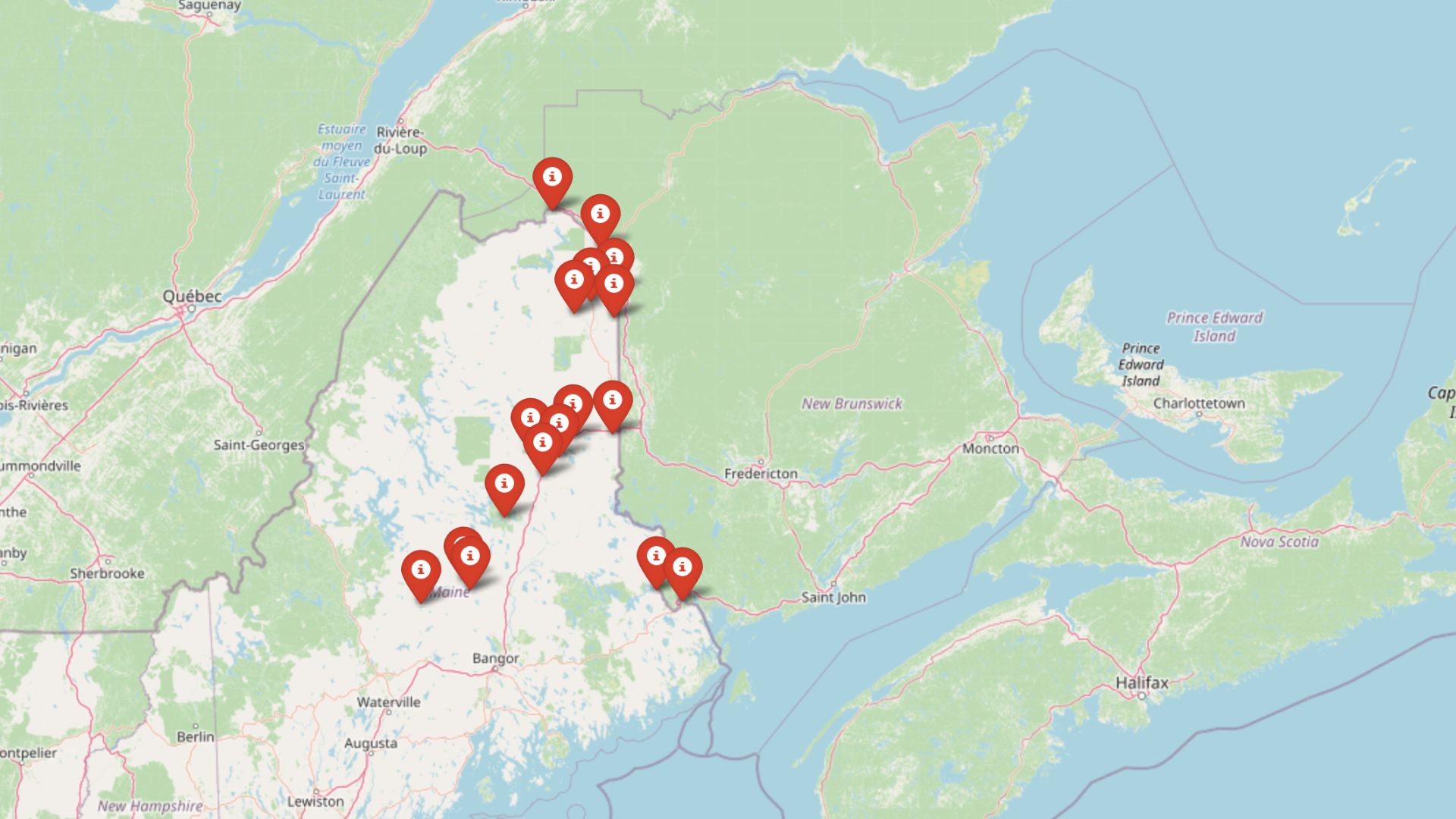
The latest Zillow Home Value Index shows that affordable homes still exist in Maine—if you know where to look. These 17 small towns stand out in June 2025 for having some of the lowest median home prices in the state, offering real opportunities for buyers tired of sky-high listings. Far from the crowded coastlines, many of these places have held steady for years, quietly resisting the spikes seen elsewhere. For anyone craving small-town life without the big price tag, this list is a smart place to start.
17. Patten – 0.48% Home Price Increase Since 2024

- 2010: N/A
- 2011: N/A
- 2012: N/A
- 2013: N/A
- 2014: N/A
- 2015: N/A
- 2016: N/A
- 2017: N/A
- 2018: N/A
- 2019: N/A
- 2020: N/A
- 2021: N/A
- 2022: N/A
- 2023: N/A
- 2024: $161,114
- 2025: $161,884 (+$771, +0.48% from previous year)
Patten has only recently appeared in Zillow’s home value tracking, but the most recent figures show just a small increase of less than 1% from 2024 to 2025. At under $162,000, it’s the most affordable town on this list, despite its modest rise. With so few data points available, it’s difficult to track long-term trends here, but prices remain well below state averages.
Patten – Quiet Living in Northern Penobscot County
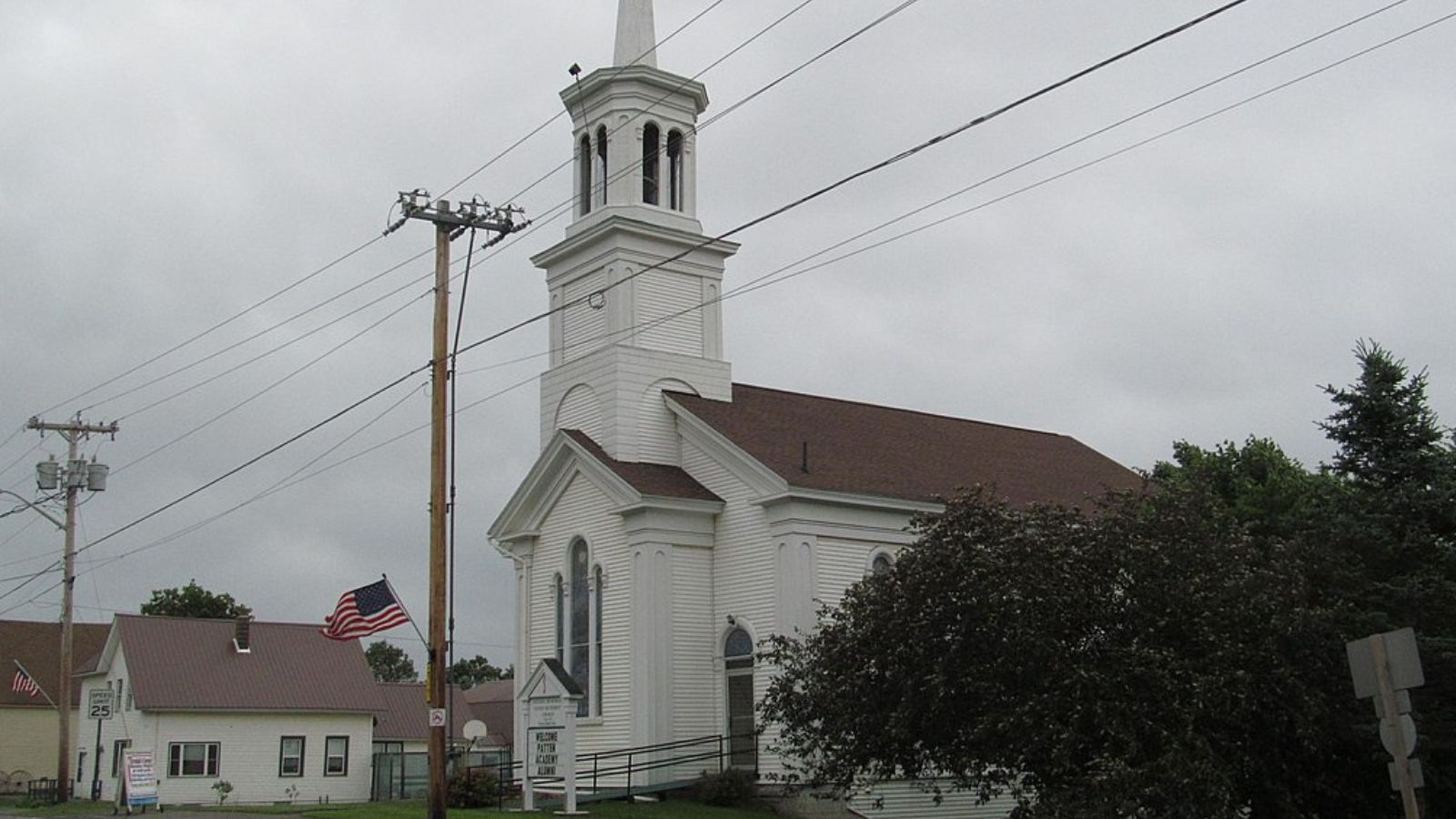
Located near the entrance to Baxter State Park in northern Maine, Patten is a rural town known for its peaceful surroundings and proximity to outdoor recreation. It’s a favorite for snowmobilers, hikers, and those seeking access to the Katahdin Woods and Waters National Monument. The town’s remoteness contributes to its affordability, with limited inventory keeping price movement minimal so far.
With a tight-knit community and few recent new developments, Patten’s small year-over-year price change reflects a stable but static housing market. However, given its scenic location and access to wilderness areas, it may attract more interest in the coming years as remote work options continue to spread.
16. Guilford – 60.3% Home Price Increase Since 2019
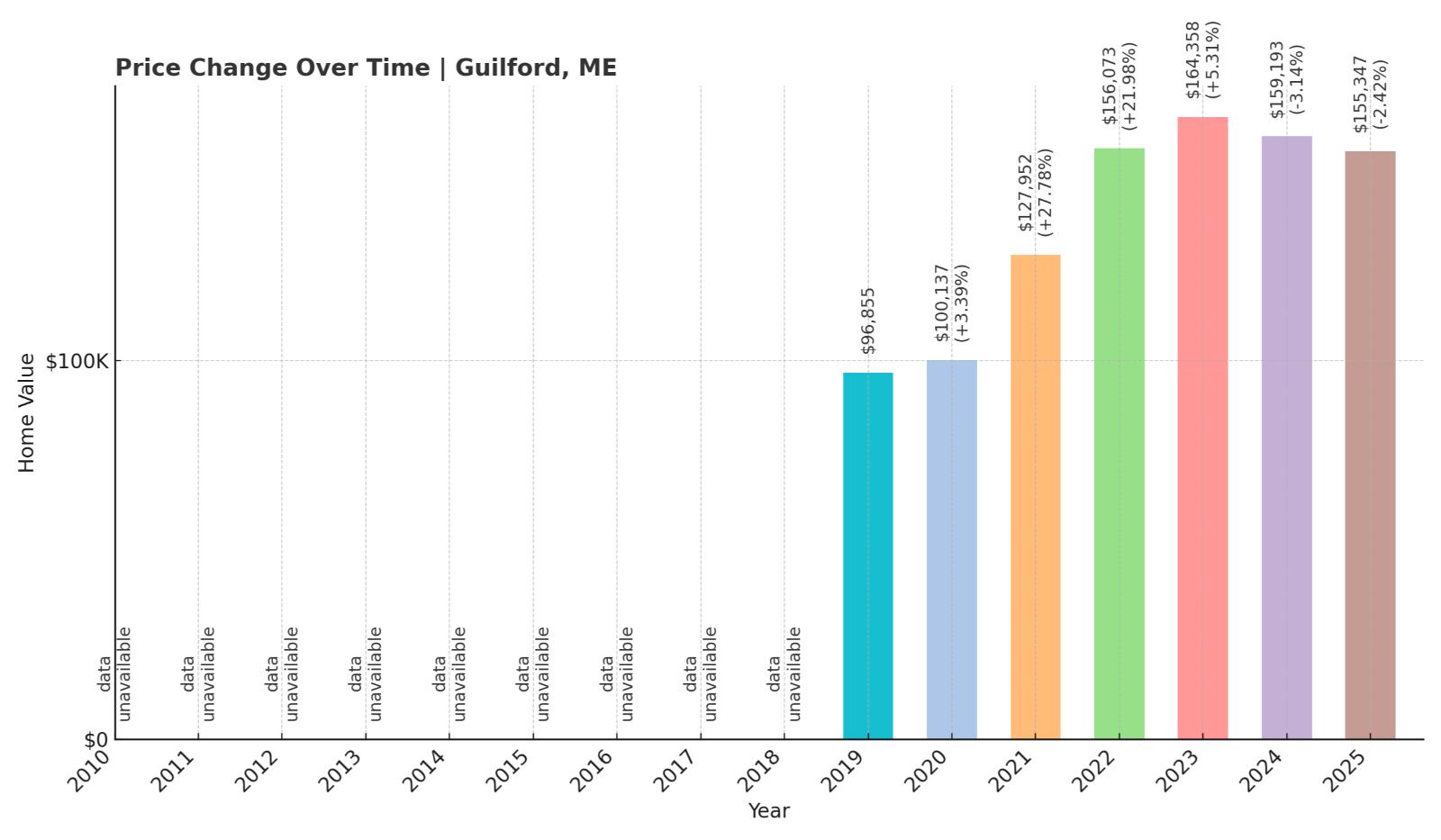
- 2010: N/A
- 2011: N/A
- 2012: N/A
- 2013: N/A
- 2014: N/A
- 2015: N/A
- 2016: N/A
- 2017: N/A
- 2018: N/A
- 2019: $96,855
- 2020: $100,137 (+$3,282, +3.39% from previous year)
- 2021: $127,952 (+$27,815, +27.78% from previous year)
- 2022: $156,073 (+$28,121, +21.98% from previous year)
- 2023: $164,358 (+$8,285, +5.31% from previous year)
- 2024: $159,193 (-$5,165, -3.14% from previous year)
- 2025: $155,347 (-$3,846, -2.42% from previous year)
Home prices in Guilford surged between 2019 and 2022, with double-digit percentage increases for three straight years. However, values have dipped slightly in the past two years. Even after the correction, the 2025 figure still reflects a 60% increase from 2019, signaling notable growth in the early 2020s followed by a modest retreat.
Guilford – Early Gains, Recent Cooling
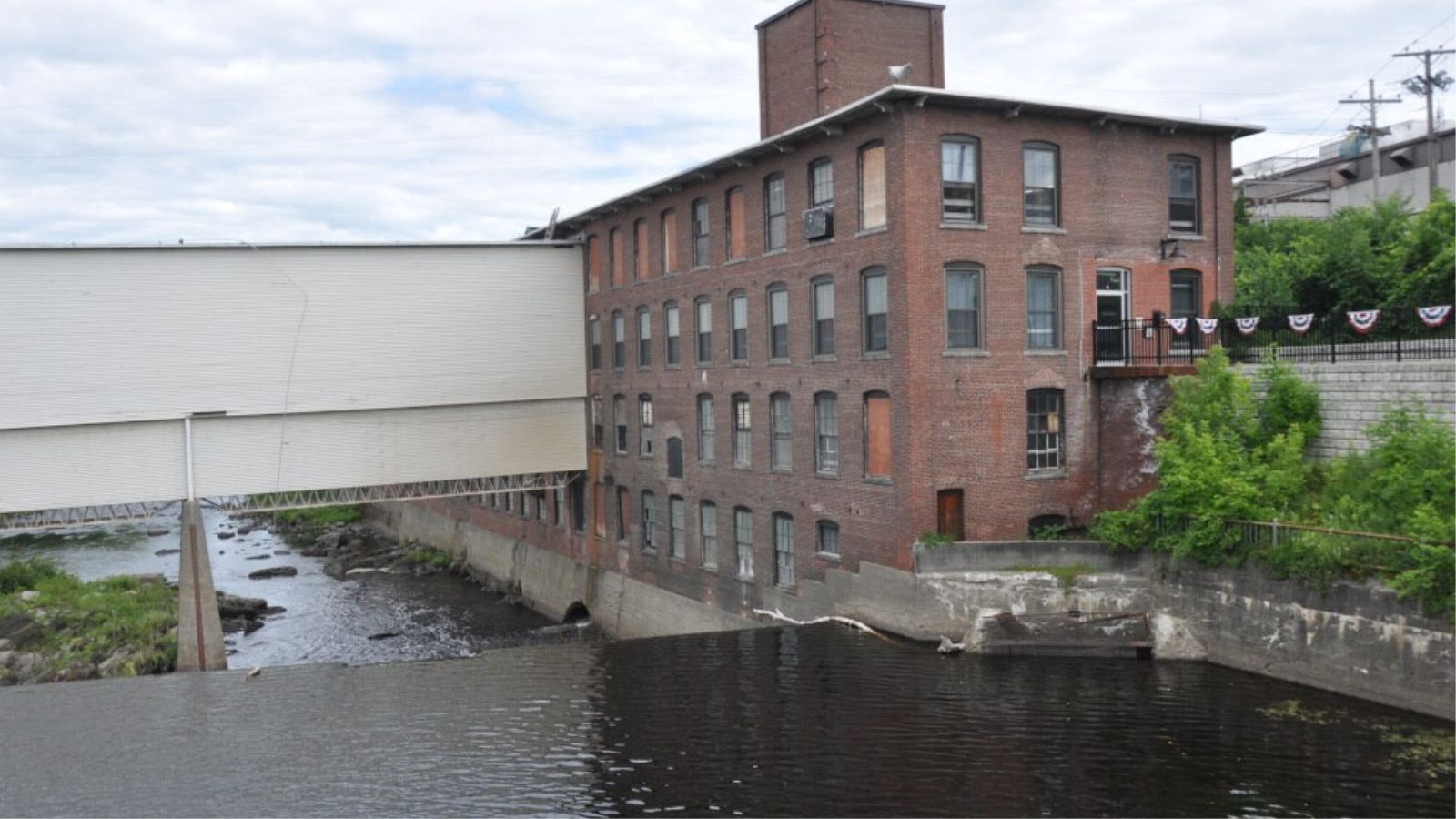
Sitting along the Piscataquis River, Guilford offers a scenic, small-town feel with historic charm and basic amenities. It gained attention in 2020 when the town’s manufacturing base expanded, bringing temporary real estate interest. That may help explain the steep growth in home values through 2022.
More recently, however, Guilford has experienced a mild market correction, likely due to broader regional stabilization in rural home prices. Despite the cooling, the current median home value still makes it one of Maine’s most affordable communities, especially for buyers looking outside the coastal corridor.
15. Caribou – 35.3% Home Price Increase Since 2010
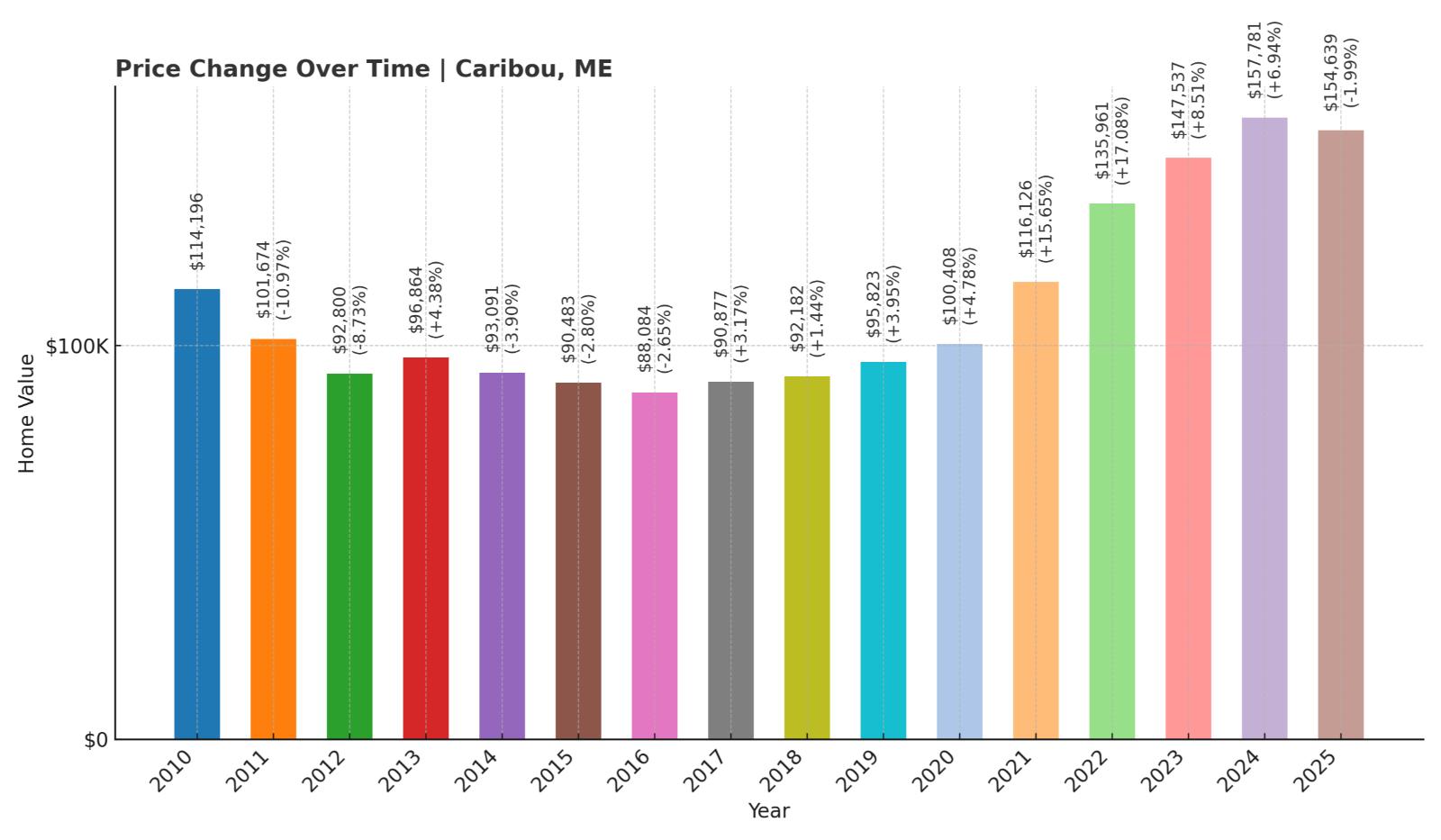
- 2010: $114,196
- 2011: $101,674 (-$12,523, -10.97% from previous year)
- 2012: $92,800 (-$8,874, -8.73% from previous year)
- 2013: $96,864 (+$4,064, +4.38% from previous year)
- 2014: $93,091 (-$3,773, -3.90% from previous year)
- 2015: $90,483 (-$2,607, -2.80% from previous year)
- 2016: $88,084 (-$2,399, -2.65% from previous year)
- 2017: $90,877 (+$2,793, +3.17% from previous year)
- 2018: $92,182 (+$1,304, +1.44% from previous year)
- 2019: $95,823 (+$3,641, +3.95% from previous year)
- 2020: $100,408 (+$4,585, +4.78% from previous year)
- 2021: $116,126 (+$15,719, +15.66% from previous year)
- 2022: $135,961 (+$19,835, +17.08% from previous year)
- 2023: $147,537 (+$11,576, +8.51% from previous year)
- 2024: $157,781 (+$10,245, +6.94% from previous year)
- 2025: $154,639 (-$3,142, -1.99% from previous year)
Caribou’s home prices declined steadily from 2010 through 2016 before turning the corner. Since 2017, the town has seen mostly consistent annual increases, peaking in 2024 before a slight dip in 2025. Still, compared to 2010, prices are up more than 35% over the 15-year span.
Caribou – Economic Shifts and Market Recovery
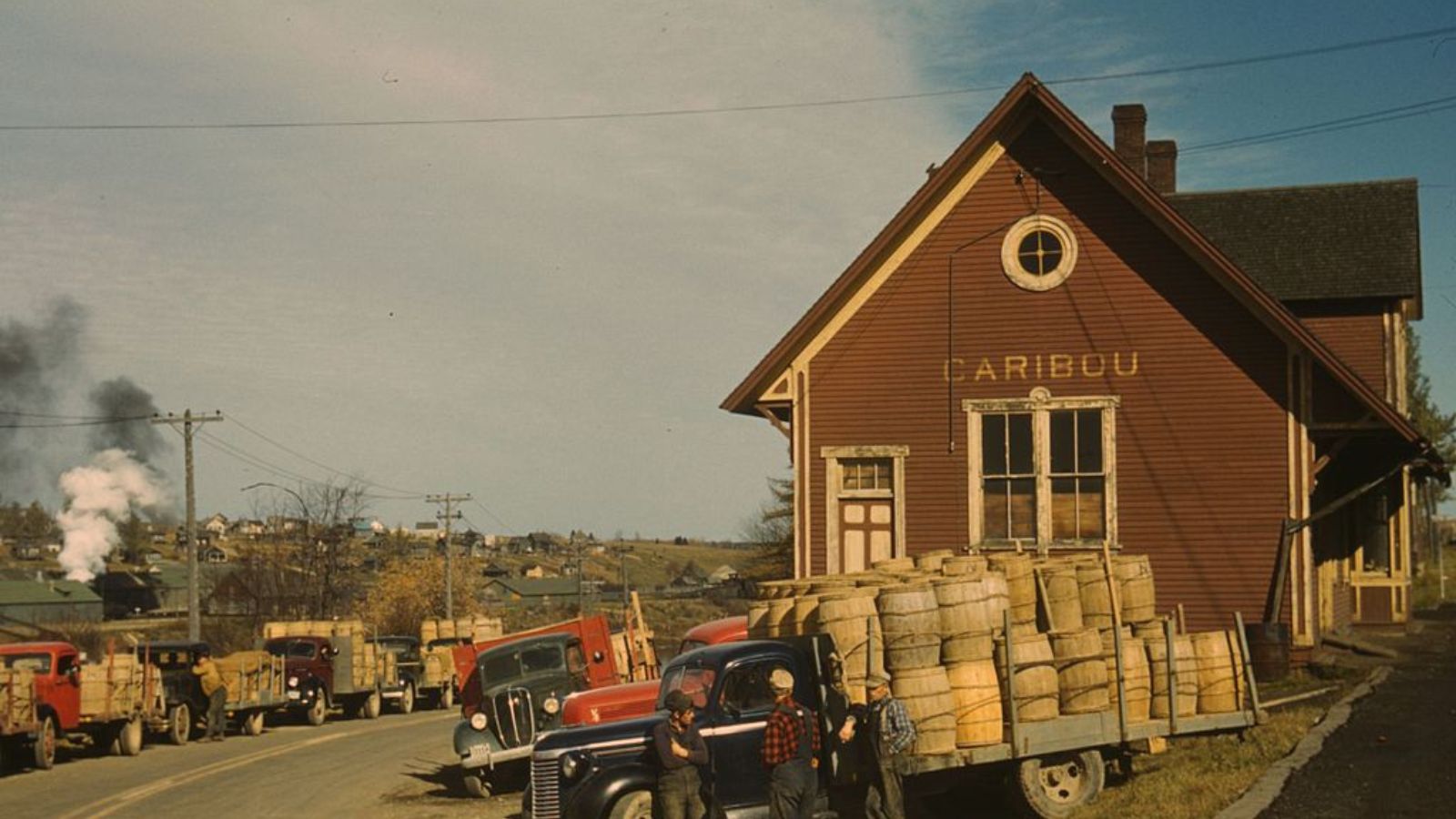
As one of Aroostook County’s key hubs, Caribou is known for its cold winters and agricultural economy. It had a long stretch of stagnant or declining prices, likely linked to job losses and population decline in the early 2010s. But in recent years, increased interest in small-town living and modest economic rebounds have helped push values up.
Even with its recent price gains, Caribou remains one of Maine’s most affordable cities. Buyers looking for larger properties or multifamily homes at low prices often find solid opportunities here. It may also appeal to retirees and veterans, as it’s home to several health facilities and a regional VA clinic.
14. Millinocket – 141.5% Home Price Increase Since 2012
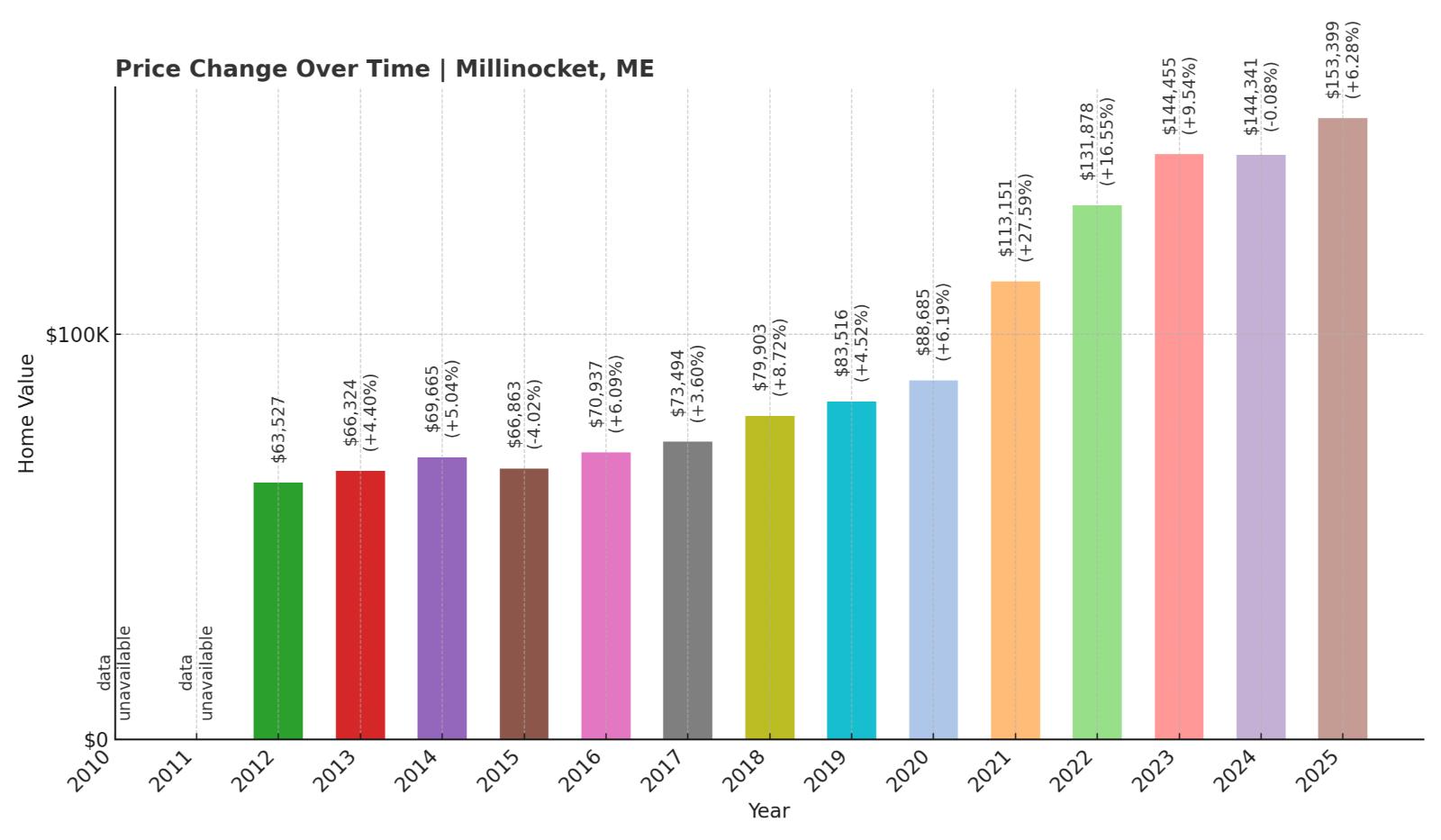
- 2010: N/A
- 2011: N/A
- 2012: $63,527
- 2013: $66,324 (+$2,797, +4.40% from previous year)
- 2014: $69,665 (+$3,341, +5.04% from previous year)
- 2015: $66,863 (-$2,802, -4.02% from previous year)
- 2016: $70,937 (+$4,074, +6.09% from previous year)
- 2017: $73,494 (+$2,558, +3.61% from previous year)
- 2018: $79,903 (+$6,408, +8.72% from previous year)
- 2019: $83,516 (+$3,613, +4.52% from previous year)
- 2020: $88,685 (+$5,170, +6.19% from previous year)
- 2021: $113,151 (+$24,466, +27.59% from previous year)
- 2022: $131,878 (+$18,726, +16.55% from previous year)
- 2023: $144,455 (+$12,577, +9.54% from previous year)
- 2024: $144,341 (-$114, -0.08% from previous year)
- 2025: $153,399 (+$9,058, +6.28% from previous year)
Millinocket has seen remarkable growth since 2012, with a 141% increase in home values over that time. While prices held steady in 2024, they rebounded in 2025. This consistent growth over more than a decade reflects renewed interest in this former mill town.
Millinocket – From Industrial Decline to Outdoor Destination
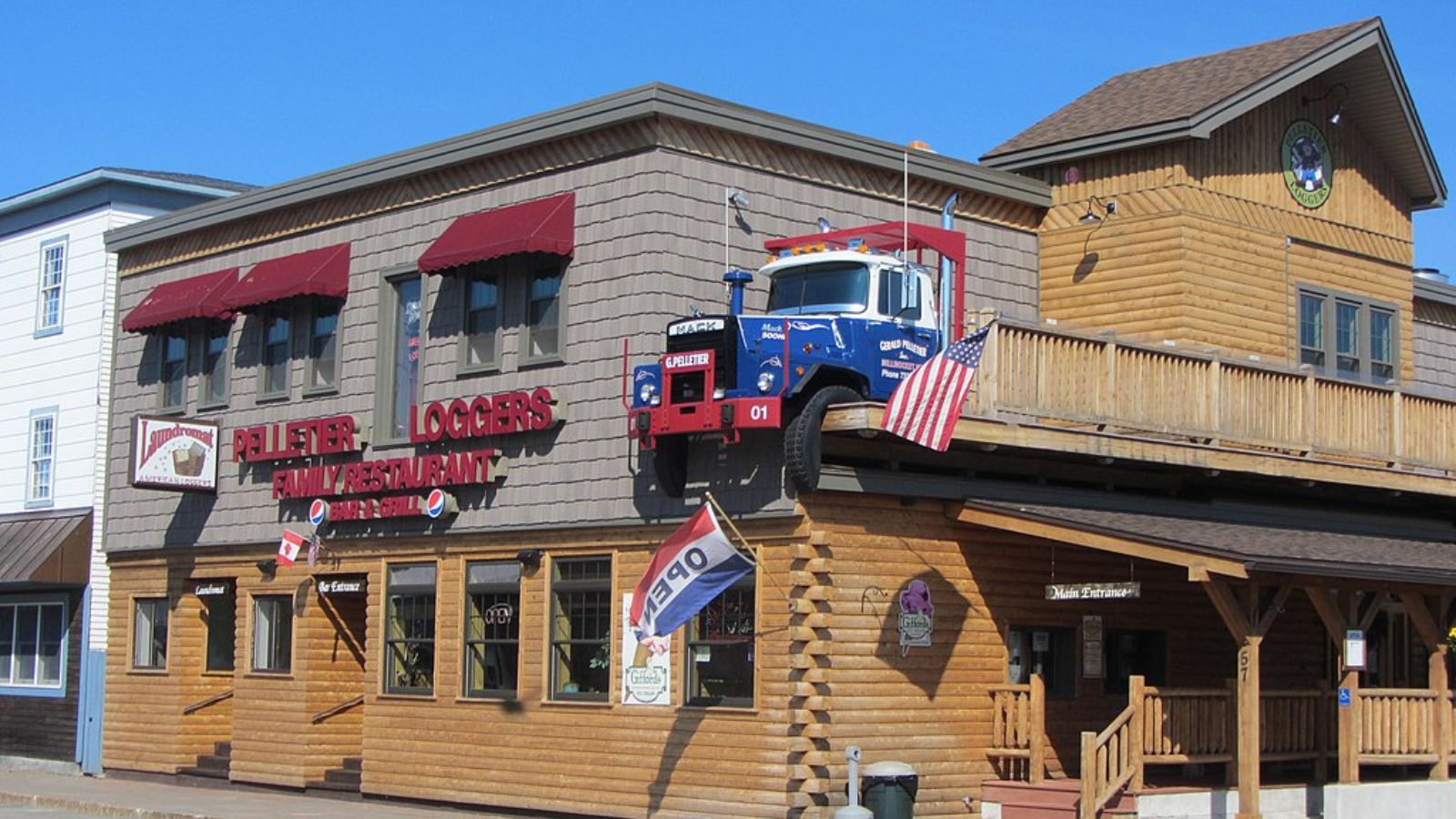
David Wilson, CC BY 2.0, via Wikimedia Commons
Once heavily reliant on the paper industry, Millinocket has reinvented itself as a base for outdoor tourism. Located near Mount Katahdin and the Appalachian Trail’s northern terminus, it has attracted new residents and investors who see potential in the area’s access to nature.
The jump in prices since 2020 aligns with growing interest in adventure tourism, vacation homes, and remote work opportunities. At just over $150,000 in 2025, the town is still quite affordable compared to the rest of the state, but its upward trajectory shows no signs of slowing.
13. Madawaska – 93.5% Home Price Increase Since 2011
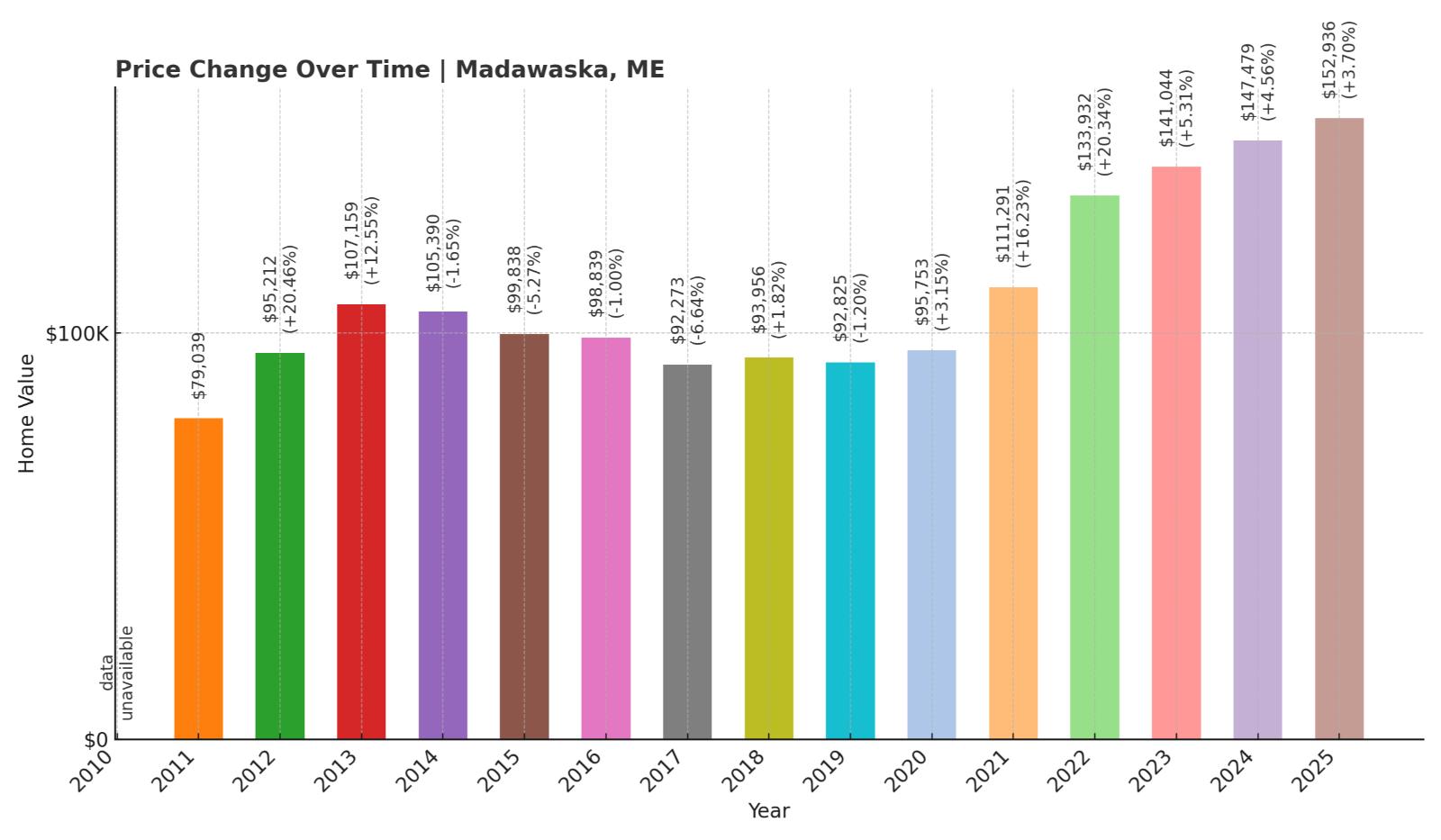
- 2010: N/A
- 2011: $79,039
- 2012: $95,212 (+$16,173, +20.46% from previous year)
- 2013: $107,159 (+$11,947, +12.55% from previous year)
- 2014: $105,390 (-$1,770, -1.65% from previous year)
- 2015: $99,838 (-$5,551, -5.27% from previous year)
- 2016: $98,839 (-$999, -1.00% from previous year)
- 2017: $92,273 (-$6,566, -6.64% from previous year)
- 2018: $93,956 (+$1,683, +1.82% from previous year)
- 2019: $92,825 (-$1,131, -1.20% from previous year)
- 2020: $95,753 (+$2,928, +3.15% from previous year)
- 2021: $111,291 (+$15,538, +16.23% from previous year)
- 2022: $133,932 (+$22,641, +20.34% from previous year)
- 2023: $141,044 (+$7,112, +5.31% from previous year)
- 2024: $147,479 (+$6,435, +4.56% from previous year)
- 2025: $152,936 (+$5,456, +3.70% from previous year)
Madawaska’s prices have almost doubled since 2011, with a strong run beginning in 2020. After some minor declines in the mid-2010s, the market picked up momentum, and steady gains have continued into 2025. The town now ranks among the lowest-cost housing markets in Maine, despite its recent appreciation.
Madawaska – Steady Growth in the St. John Valley
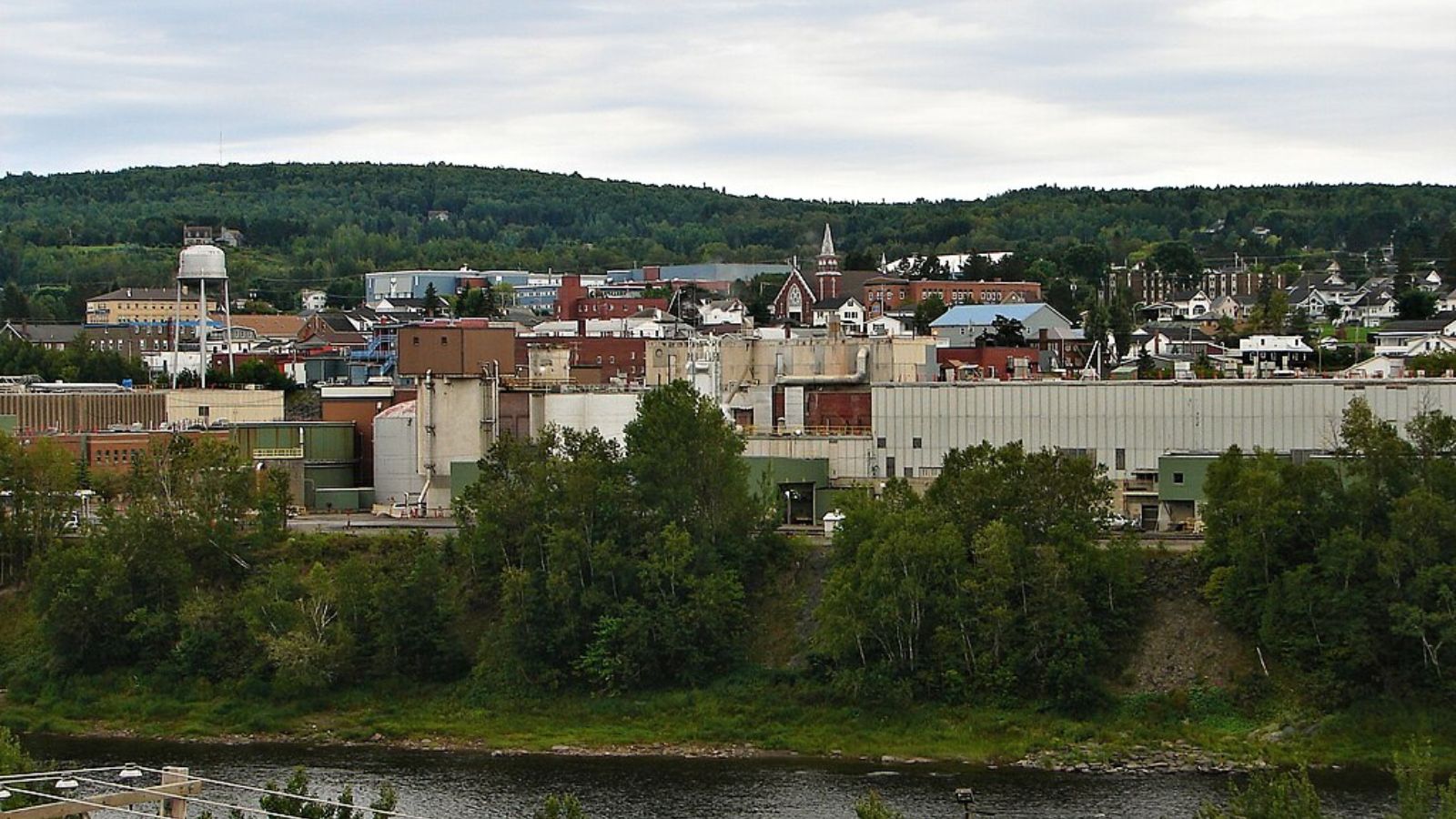
Positioned on the northern border with Canada, Madawaska is a bilingual town with deep Franco-American roots. Its economy is tied to the paper industry and cross-border trade with Edmundston, New Brunswick. Though small, the community has essential services and a unique cultural flavor that draws some buyers northward.
The steady home value increases in recent years may reflect regional economic stability and a modest population of homebuyers seeking low prices and rural tranquility. While still affordable, prices in Madawaska have been trending upward more consistently than in many other northern towns.
12. Calais – 118.9% Home Price Increase Since 2014

- 2010: N/A
- 2011: N/A
- 2012: N/A
- 2013: N/A
- 2014: $69,720
- 2015: $67,421 (-$2,299, -3.30% from previous year)
- 2016: $73,700 (+$6,279, +9.31% from previous year)
- 2017: $70,243 (-$3,456, -4.69% from previous year)
- 2018: $78,577 (+$8,333, +11.86% from previous year)
- 2019: $78,599 (+$22, +0.03% from previous year)
- 2020: $89,481 (+$10,882, +13.84% from previous year)
- 2021: $110,238 (+$20,756, +23.20% from previous year)
- 2022: $132,923 (+$22,685, +20.58% from previous year)
- 2023: $144,787 (+$11,864, +8.93% from previous year)
- 2024: $152,261 (+$7,474, +5.16% from previous year)
- 2025: $152,662 (+$401, +0.26% from previous year)
Calais has seen a remarkable jump in home values over the last decade, rising by nearly 119% since 2014. The growth spurt began in earnest around 2020, with several years of double-digit increases. Although the pace has slowed recently, 2025 prices remain well above their pre-pandemic levels.
Calais – Border Town With a Growing Market
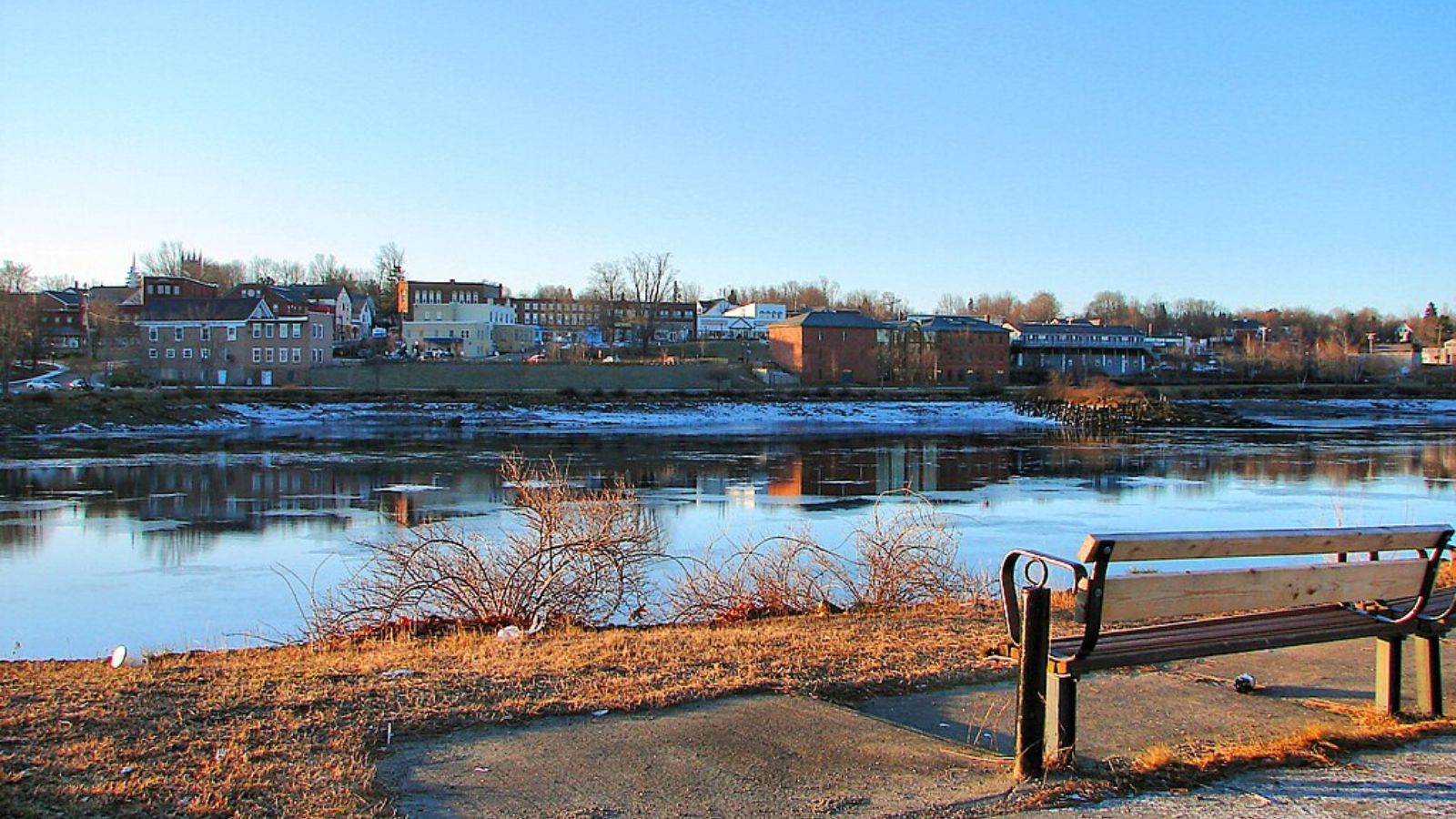
Calais is situated along the St. Croix River, directly across from New Brunswick, Canada. This border-town location has long shaped its economy and culture, with shopping and trade playing central roles. The area is also a gateway to Downeast Maine and the scenic Bold Coast.
The town’s affordability, combined with its strategic location, has likely contributed to rising interest from out-of-state buyers and retirees. While price gains have tapered off in 2025, Calais still offers a blend of accessibility and relative value that keeps it appealing in Maine’s housing market.
11. Oakfield – 0.6% Home Price Increase Since 2023
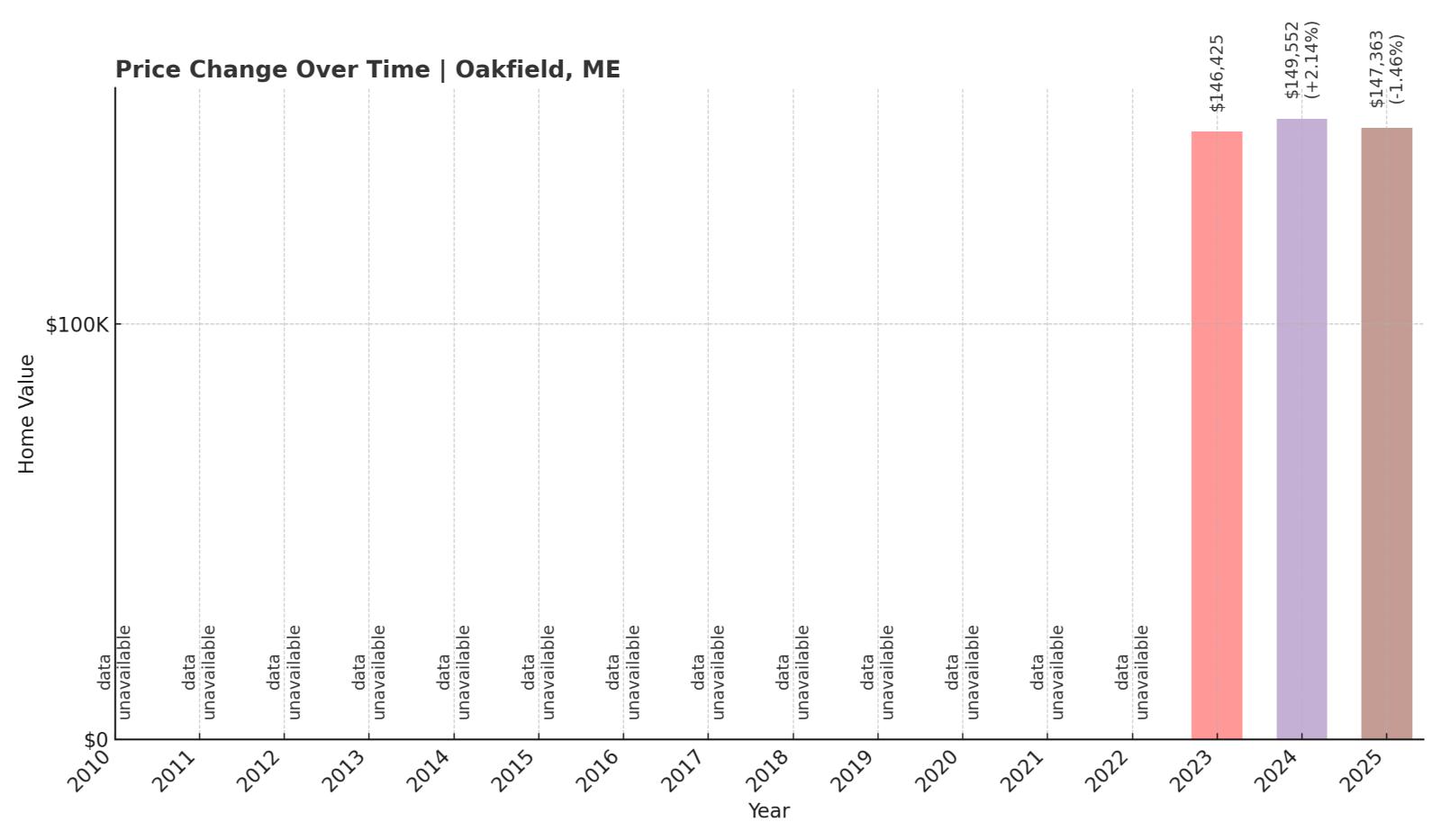
- 2010: N/A
- 2011: N/A
- 2012: N/A
- 2013: N/A
- 2014: N/A
- 2015: N/A
- 2016: N/A
- 2017: N/A
- 2018: N/A
- 2019: N/A
- 2020: N/A
- 2021: N/A
- 2022: N/A
- 2023: $146,425
- 2024: $149,552 (+$3,127, +2.14% from previous year)
- 2025: $147,363 (-$2,189, -1.46% from previous year)
Oakfield’s housing data only goes back to 2023, but in those three years, prices have barely moved—rising slightly in 2024 before dipping again in 2025. That places current values only 0.6% higher than they were two years ago, suggesting a stable but slow-moving market.
Oakfield – Steady Prices in Rural Aroostook County
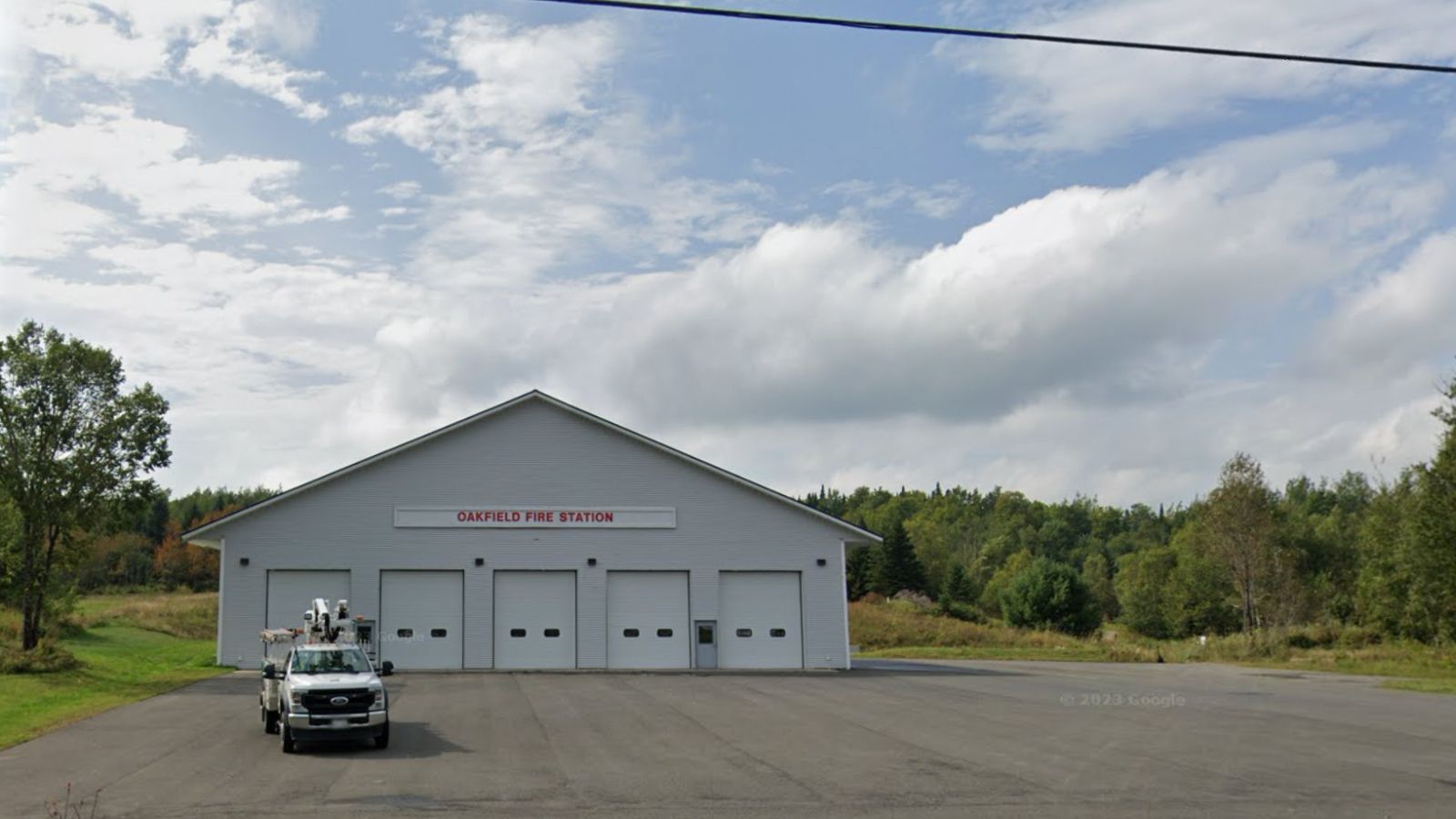
Located just off I-95 in Aroostook County, Oakfield is a small rural town known for its access to ATV trails, hunting grounds, and unspoiled forestland. It offers quiet living with scenic views and abundant outdoor opportunities. The town’s relative isolation contributes to its affordability and muted price changes.
Though market activity remains light, Oakfield’s low entry point continues to attract buyers looking for land or vacation cabins. The small decline in 2025 doesn’t indicate a significant downturn—rather, it reinforces the slow-and-steady nature of home prices in this part of the state.
10. Houlton – 95.5% Home Price Increase Since 2016
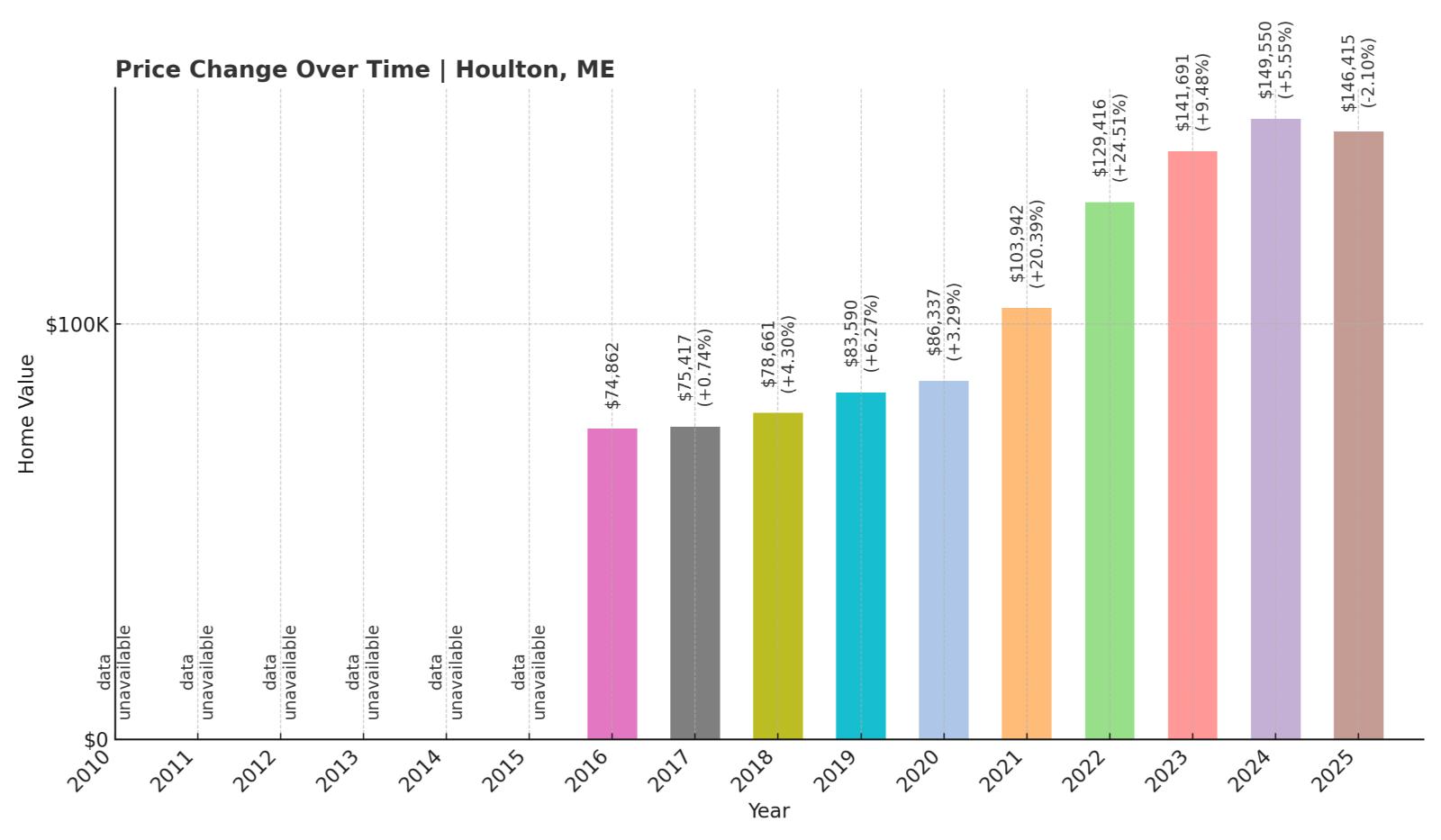
- 2010: N/A
- 2011: N/A
- 2012: N/A
- 2013: N/A
- 2014: N/A
- 2015: N/A
- 2016: $74,862
- 2017: $75,417 (+$556, +0.74% from previous year)
- 2018: $78,661 (+$3,244, +4.30% from previous year)
- 2019: $83,590 (+$4,930, +6.27% from previous year)
- 2020: $86,337 (+$2,747, +3.29% from previous year)
- 2021: $103,942 (+$17,604, +20.39% from previous year)
- 2022: $129,416 (+$25,474, +24.51% from previous year)
- 2023: $141,691 (+$12,276, +9.49% from previous year)
- 2024: $149,550 (+$7,858, +5.55% from previous year)
- 2025: $146,415 (-$3,134, -2.10% from previous year)
Since 2016, Houlton’s home prices have nearly doubled, showing consistent upward momentum until a slight pullback in 2025. Even with this minor decline, the market has grown by more than 95%, placing Houlton among Maine’s fastest-rising affordable towns in the last decade.
Houlton – Gateway to the North
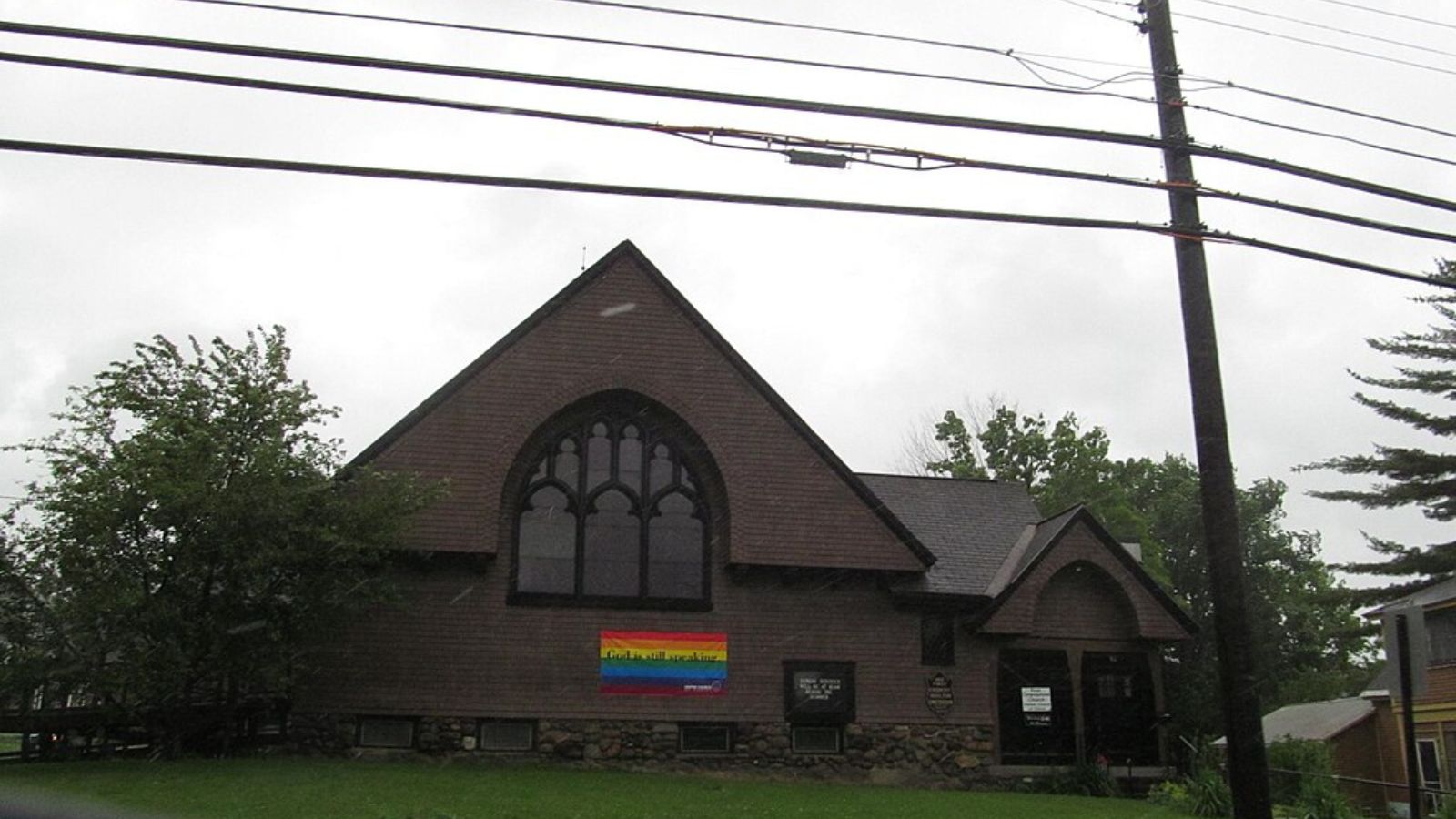
Houlton sits near the Canadian border along I-95 and serves as a commercial and administrative center for Aroostook County. Its location makes it a strategic stop for both tourism and transport. The town features a charming historic downtown and a mix of colonial and farmhouse-style homes.
Despite being far from Maine’s coastal hotspots, Houlton has seen strong home price appreciation, possibly driven by low inventory, cross-border migration, and increasing interest in rural living. Its 2025 dip may simply reflect price normalization after several rapid-growth years.
9. Sherman – 59.7% Home Price Increase Since 2019

- 2010: N/A
- 2011: N/A
- 2012: N/A
- 2013: N/A
- 2014: N/A
- 2015: N/A
- 2016: N/A
- 2017: N/A
- 2018: N/A
- 2019: $91,656
- 2020: $93,779 (+$2,123, +2.32% from previous year)
- 2021: $112,341 (+$18,562, +19.79% from previous year)
- 2022: $134,151 (+$21,810, +19.41% from previous year)
- 2023: $144,049 (+$9,898, +7.38% from previous year)
- 2024: $142,276 (-$1,773, -1.23% from previous year)
- 2025: $146,415 (+$4,139, +2.91% from previous year)
Home prices in Sherman have climbed nearly 60% since 2019. The largest gains came in 2021 and 2022, with continued moderate appreciation in 2023. Although there was a brief dip in 2024, prices recovered again in 2025, pushing the town’s median home value above $146,000.
Sherman – Small Town With Recent Growth

Sherman is tucked into northern Penobscot County and offers a quiet, rural atmosphere with quick access to Baxter State Park and the Katahdin region. Its appeal lies in its scenic beauty and space—an ideal setting for outdoor enthusiasts or anyone looking to settle in a peaceful, wooded community.
With its modest but steady price increases, Sherman has begun drawing attention from budget-conscious buyers and seasonal residents. Infrastructure remains limited, but the affordability and natural charm help explain its gradual rise in value over the past five years.
8. Brownville – 76.7% Home Price Increase Since 2019
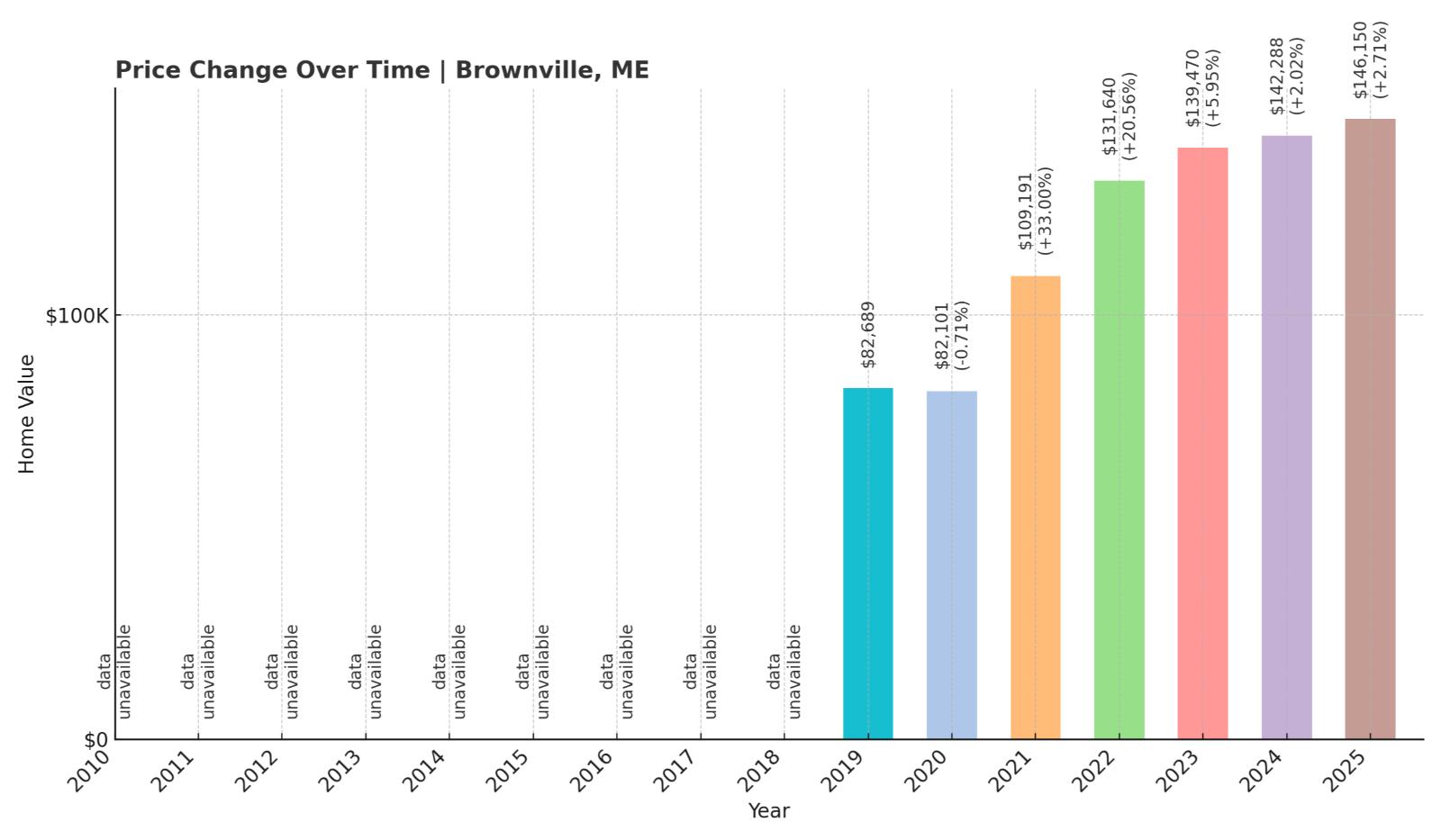
- 2010: N/A
- 2011: N/A
- 2012: N/A
- 2013: N/A
- 2014: N/A
- 2015: N/A
- 2016: N/A
- 2017: N/A
- 2018: N/A
- 2019: $82,689
- 2020: $82,101 (-$589, -0.71% from previous year)
- 2021: $109,191 (+$27,091, +33.00% from previous year)
- 2022: $131,640 (+$22,448, +20.56% from previous year)
- 2023: $139,470 (+$7,830, +5.95% from previous year)
- 2024: $142,288 (+$2,818, +2.02% from previous year)
- 2025: $146,150 (+$3,862, +2.71% from previous year)
Brownville’s housing market has surged since 2020, climbing nearly 77% since 2019. After a flat 2020, three consecutive years of double-digit increases lifted the town into a new price range. More modest growth in 2024 and 2025 indicates stabilization at this new level.
Brownville – Rapid Rise in Piscataquis County

Located in central Maine, Brownville is a former logging community that now offers a low-key lifestyle with affordable homes and expansive landscapes. It’s near Sebec Lake and several ATV trail systems, making it a popular spot for outdoor recreation.
Brownville’s affordability has become a draw for both remote workers and retirees, helping to drive up demand in recent years. While it remains a budget-friendly option, prices have risen fast enough to suggest growing interest in this once-overlooked town.
7. Island Falls – 79.9% Home Price Increase Since 2017
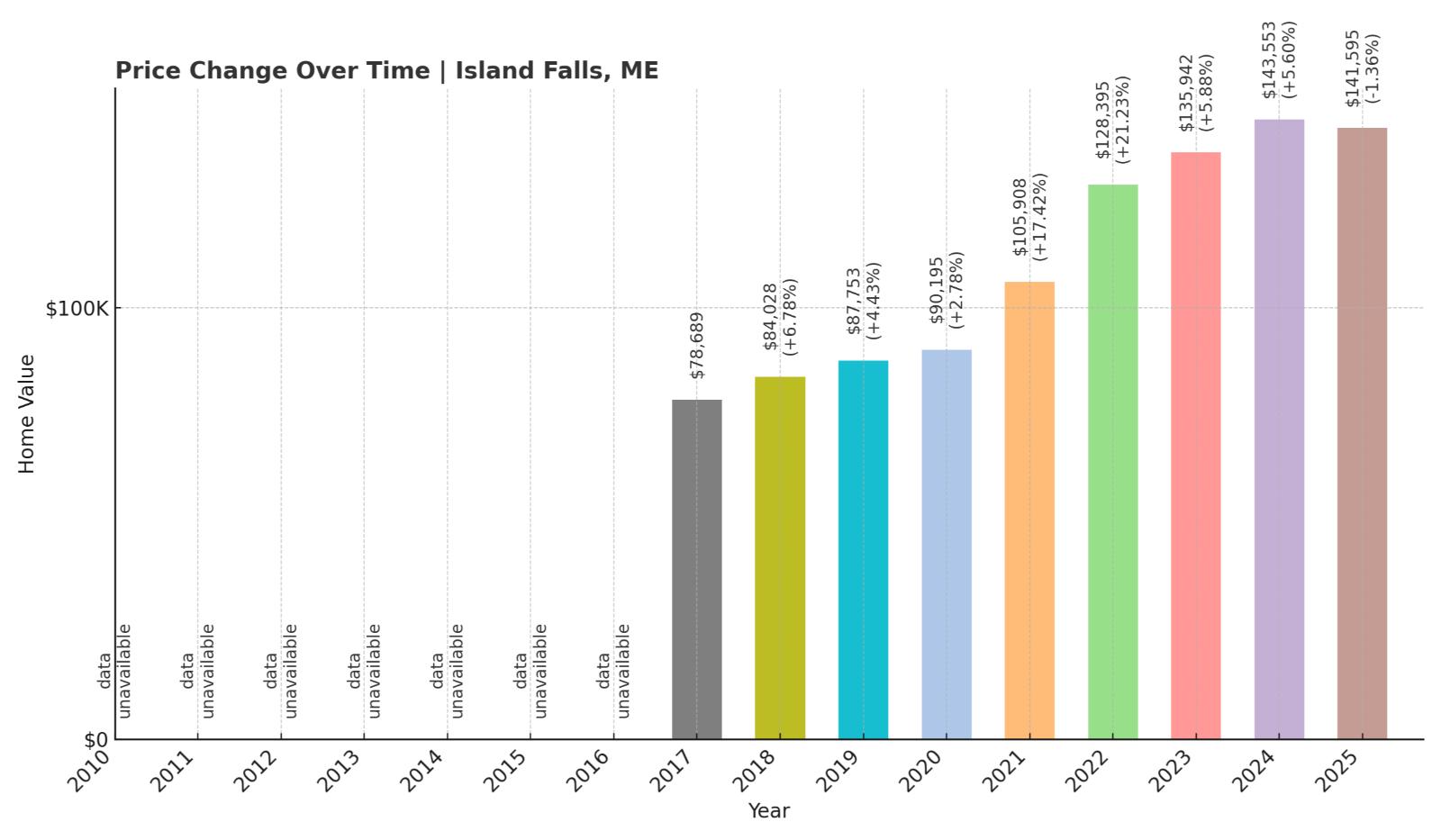
- 2010: N/A
- 2011: N/A
- 2012: N/A
- 2013: N/A
- 2014: N/A
- 2015: N/A
- 2016: N/A
- 2017: $78,689
- 2018: $84,028 (+$5,339, +6.78% from previous year)
- 2019: $87,753 (+$3,726, +4.43% from previous year)
- 2020: $90,195 (+$2,442, +2.78% from previous year)
- 2021: $105,908 (+$15,713, +17.42% from previous year)
- 2022: $128,395 (+$22,487, +21.23% from previous year)
- 2023: $135,942 (+$7,547, +5.88% from previous year)
- 2024: $143,553 (+$7,611, +5.60% from previous year)
- 2025: $141,595 (-$1,958, -1.36% from previous year)
Island Falls has posted impressive gains over the last eight years, with home values rising almost 80% since 2017. That growth has started to level off, with a small decline in 2025 following a strong multi-year run. Still, prices remain well above their pre-pandemic levels.
Island Falls – Scenic and Affordable
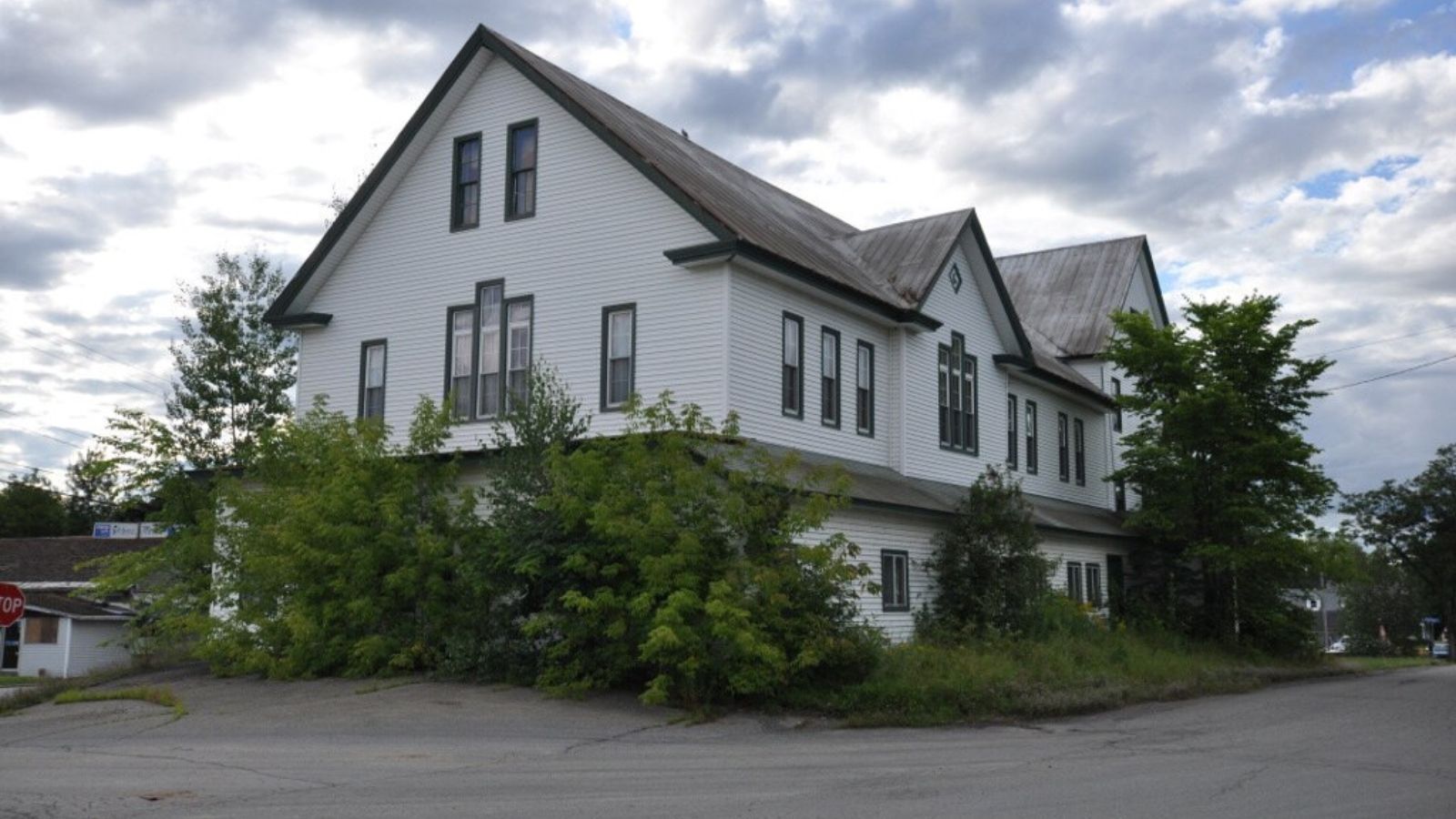
Island Falls is located in southern Aroostook County and sits along Pleasant Lake and the Mattawamkeag River. Known for its natural beauty and proximity to Baxter State Park, the town is a destination for outdoor lovers seeking peace and quiet without high housing costs.
Though small, the town has benefited from Maine’s growing popularity among remote workers and seasonal visitors. The recent price dip may signal a cooling off, but its longer-term trend still reflects strong upward movement and rising interest in this picturesque area.
6. Washburn – 113.4% Home Price Increase Since 2012
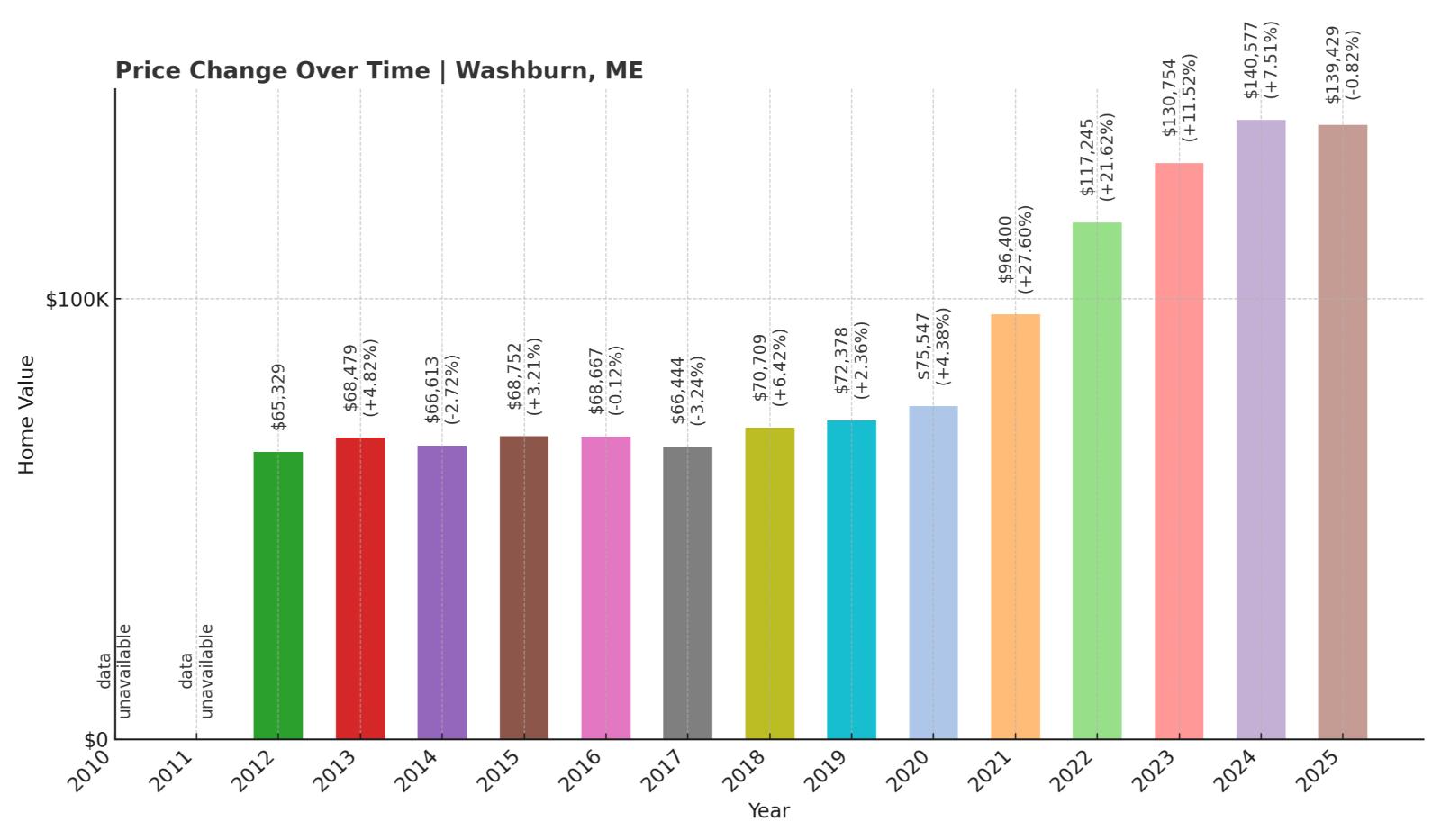
- 2010: N/A
- 2011: N/A
- 2012: $65,329
- 2013: $68,479 (+$3,151, +4.82% from previous year)
- 2014: $66,613 (-$1,866, -2.73% from previous year)
- 2015: $68,752 (+$2,139, +3.21% from previous year)
- 2016: $68,667 (-$86, -0.12% from previous year)
- 2017: $66,444 (-$2,222, -3.24% from previous year)
- 2018: $70,709 (+$4,264, +6.42% from previous year)
- 2019: $72,378 (+$1,669, +2.36% from previous year)
- 2020: $75,547 (+$3,169, +4.38% from previous year)
- 2021: $96,400 (+$20,853, +27.60% from previous year)
- 2022: $117,245 (+$20,845, +21.62% from previous year)
- 2023: $130,754 (+$13,509, +11.52% from previous year)
- 2024: $140,577 (+$9,823, +7.51% from previous year)
- 2025: $139,429 (-$1,148, -0.82% from previous year)
Washburn’s home values have more than doubled since 2012, thanks to a steady series of gains, especially from 2020 through 2023. A small drop in 2025 suggests prices are leveling out after several years of rapid appreciation. Still, its growth over the long term is among the highest in rural Maine.
Washburn – Long-Term Growth in Aroostook County

Washburn is a quiet agricultural community in the northern part of the state, close to Presque Isle and the Canadian border. Its housing stock includes modest single-family homes on generous lots, with easy access to the area’s farming and outdoor industries.
The town’s growth has likely been driven by affordability and availability, making it attractive to both locals and newcomers seeking space without the cost. With prices now hovering around $140,000, Washburn remains accessible while reflecting broader upward momentum in northern Maine’s housing market.
5. Fort Fairfield – 56.5% Home Price Increase Since 2010
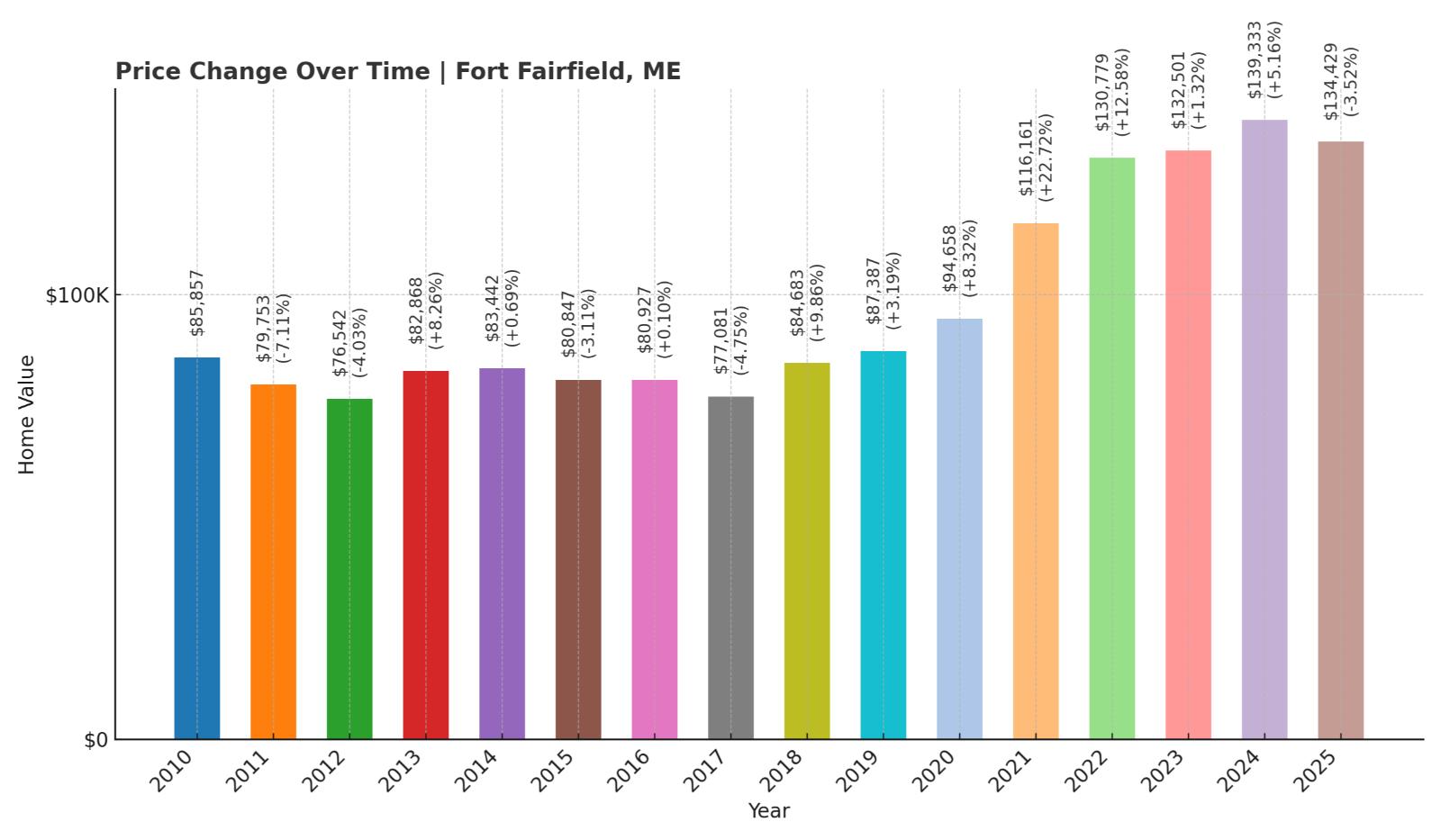
- 2010: $85,857
- 2011: $79,753 (-$6,104, -7.11% from previous year)
- 2012: $76,542 (-$3,211, -4.03% from previous year)
- 2013: $82,868 (+$6,326, +8.26% from previous year)
- 2014: $83,442 (+$574, +0.69% from previous year)
- 2015: $80,847 (-$2,595, -3.11% from previous year)
- 2016: $80,927 (+$80, +0.10% from previous year)
- 2017: $77,081 (-$3,846, -4.75% from previous year)
- 2018: $84,683 (+$7,602, +9.86% from previous year)
- 2019: $87,387 (+$2,704, +3.19% from previous year)
- 2020: $94,658 (+$7,271, +8.32% from previous year)
- 2021: $116,161 (+$21,502, +22.72% from previous year)
- 2022: $130,779 (+$14,618, +12.58% from previous year)
- 2023: $132,501 (+$1,722, +1.32% from previous year)
- 2024: $139,333 (+$6,831, +5.16% from previous year)
- 2025: $134,429 (-$4,904, -3.52% from previous year)
Home values in Fort Fairfield have increased by over 56% since 2010, despite a few dips along the way. The largest price spikes came between 2020 and 2022, followed by more moderate growth and a decline in 2025. Even with the recent drop, the town remains one of the most affordable in the state.
Fort Fairfield – Agricultural Hub With Market Fluctuations
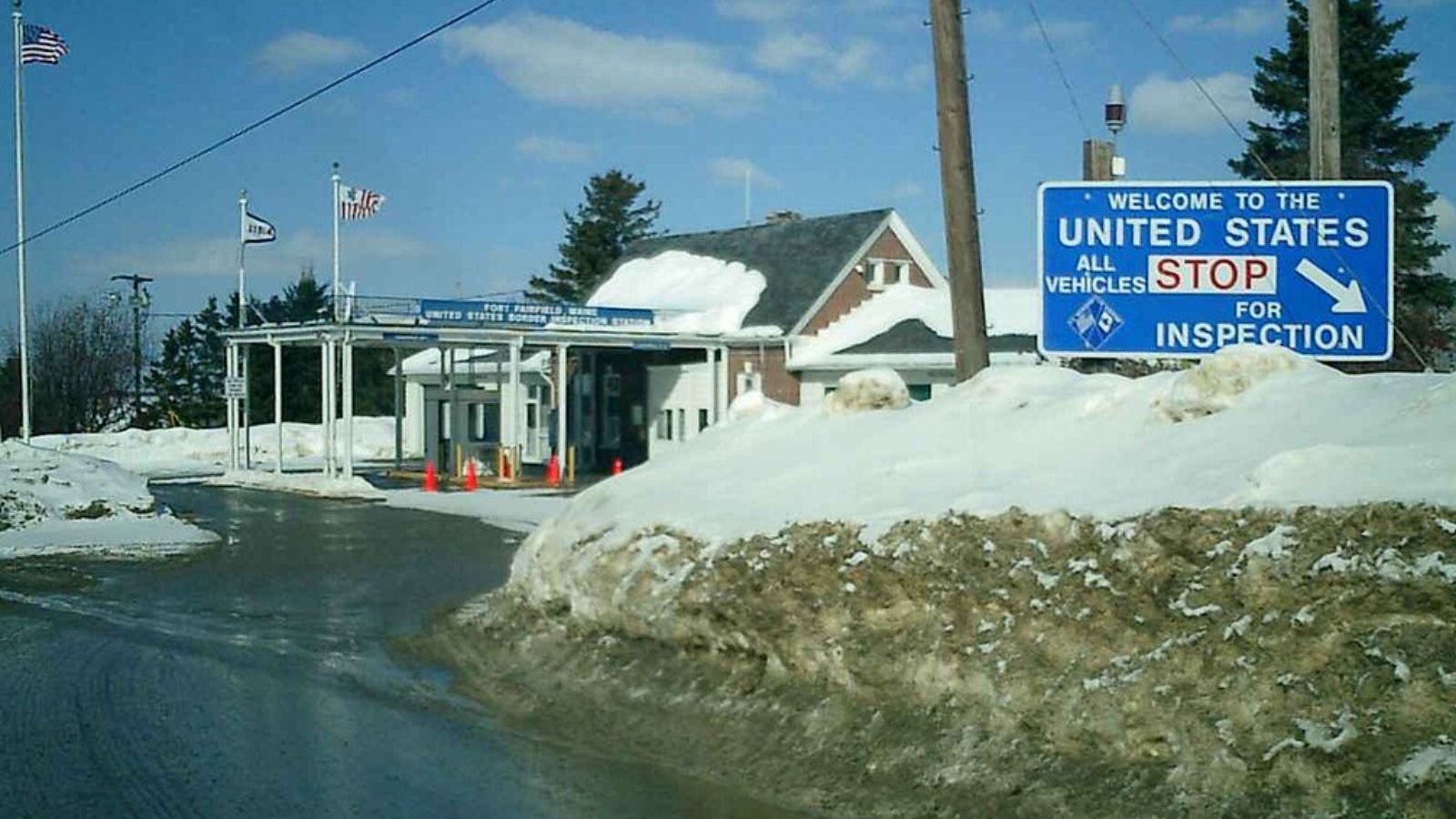
Located in Aroostook County, Fort Fairfield sits along the Canadian border and is known for its agricultural roots—particularly potato farming. The town features a mix of old farmhouses, small businesses, and community events like the Maine Potato Blossom Festival.
Home prices surged during the pandemic as demand for rural properties spiked. The 2025 price dip may be part of a natural correction after several years of strong growth. Still, the town’s affordability, scenic views, and open land keep it attractive to first-time buyers and investors alike.
4. Milo – 87.5% Home Price Increase Since 2012
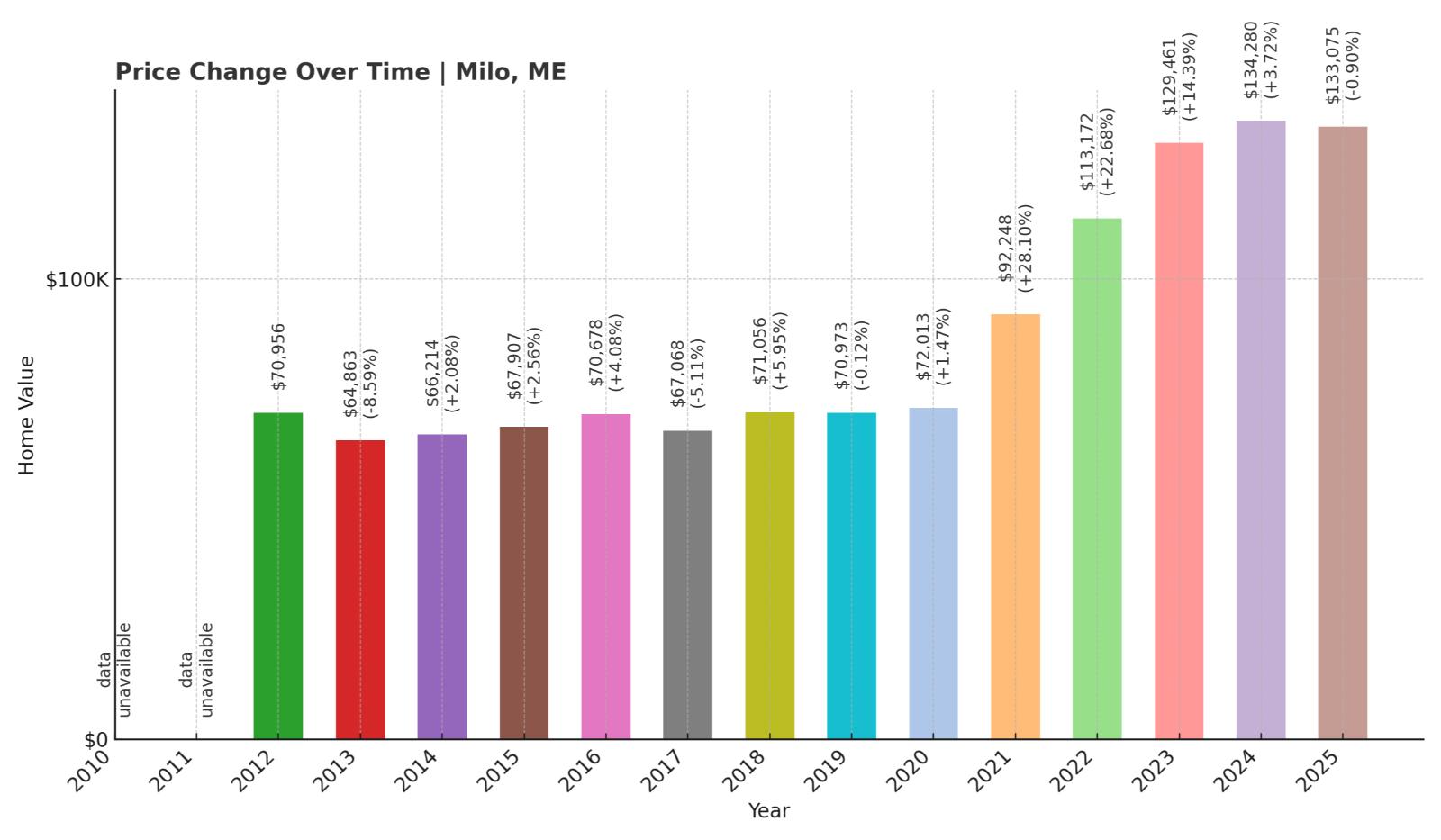
- 2010: N/A
- 2011: N/A
- 2012: $70,956
- 2013: $64,863 (-$6,093, -8.59% from previous year)
- 2014: $66,214 (+$1,351, +2.08% from previous year)
- 2015: $67,907 (+$1,693, +2.56% from previous year)
- 2016: $70,678 (+$2,772, +4.08% from previous year)
- 2017: $67,068 (-$3,611, -5.11% from previous year)
- 2018: $71,056 (+$3,988, +5.95% from previous year)
- 2019: $70,973 (-$83, -0.12% from previous year)
- 2020: $72,013 (+$1,041, +1.47% from previous year)
- 2021: $92,248 (+$20,235, +28.10% from previous year)
- 2022: $113,172 (+$20,923, +22.68% from previous year)
- 2023: $129,461 (+$16,289, +14.39% from previous year)
- 2024: $134,280 (+$4,819, +3.72% from previous year)
- 2025: $133,075 (-$1,205, -0.90% from previous year)
Despite some bumps along the way, Milo’s home prices have climbed nearly 88% since 2012. Gains were especially strong between 2020 and 2023, before growth slowed and prices edged down slightly in 2025. Still, the town’s real estate remains highly affordable by state standards.
Milo – Small-Town Charm and Steady Appeal
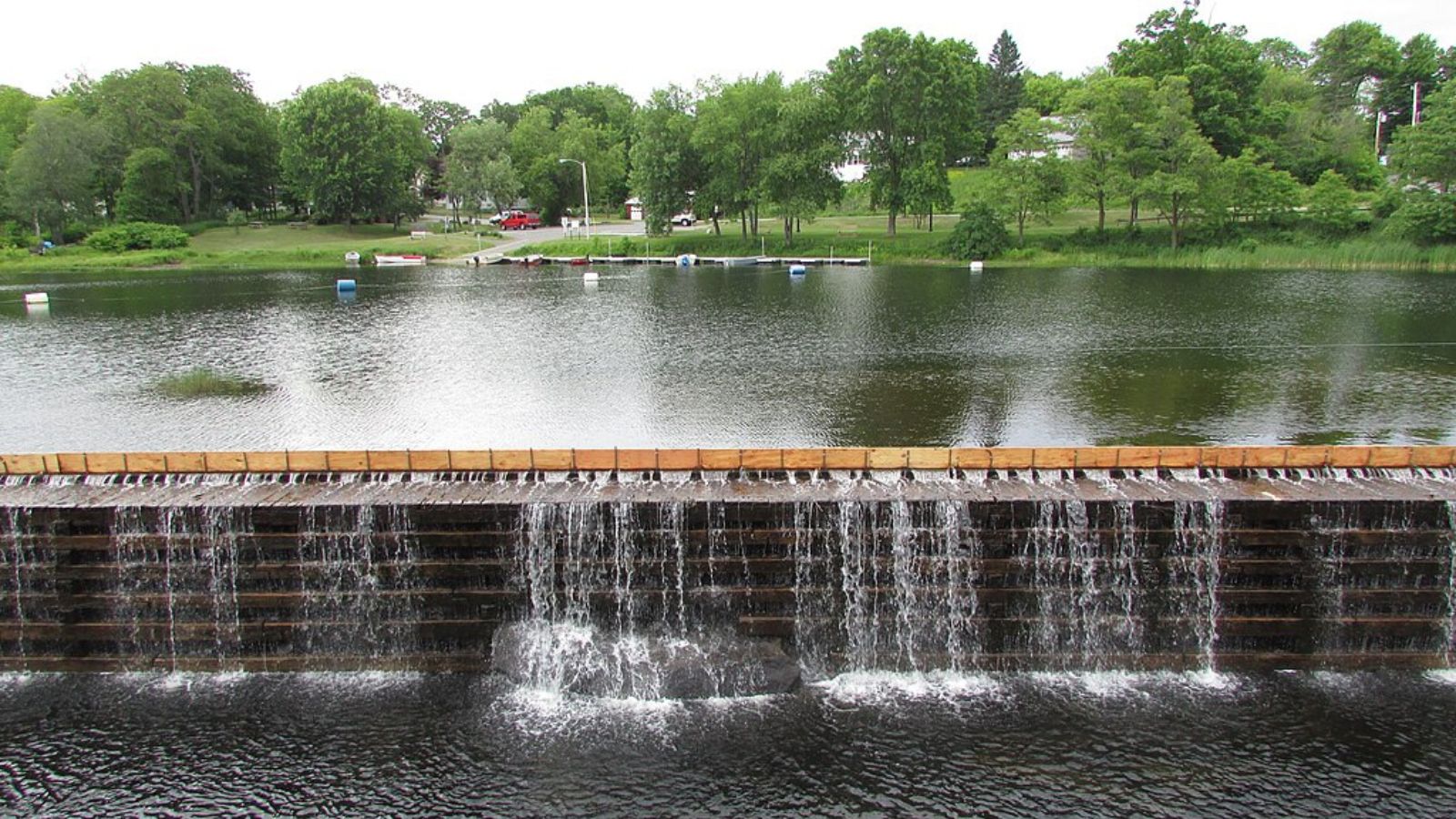
Milo is located in Piscataquis County and is known for its historic mill buildings and riverfront location at the confluence of the Sebec and Piscataquis Rivers. It’s a classic small Maine town with a mix of older homes and newer renovations.
Increased attention during the pandemic, along with affordable prices and open space, helped fuel recent growth. Though prices dipped slightly this year, the town’s upward trajectory remains intact. It continues to offer strong value for homebuyers looking for a quiet setting with essential services.
3. Woodland – 2.1% Home Price Decrease Since 2023

- 2010: N/A
- 2011: N/A
- 2012: N/A
- 2013: N/A
- 2014: N/A
- 2015: N/A
- 2016: N/A
- 2017: N/A
- 2018: N/A
- 2019: N/A
- 2020: N/A
- 2021: N/A
- 2022: N/A
- 2023: $133,970
- 2024: $143,736 (+$9,766, +7.29% from previous year)
- 2025: $130,255 (-$13,481, -9.38% from previous year)
Woodland’s home prices jumped nearly 7.3% in 2024 but reversed sharply in 2025 with a 9.4% drop. That places current values slightly below their 2023 levels, making it one of the few towns in Maine with a net decline over this short period. Despite the dip, prices remain relatively affordable overall.
Woodland – A Short-Term Slide in a Quiet Community
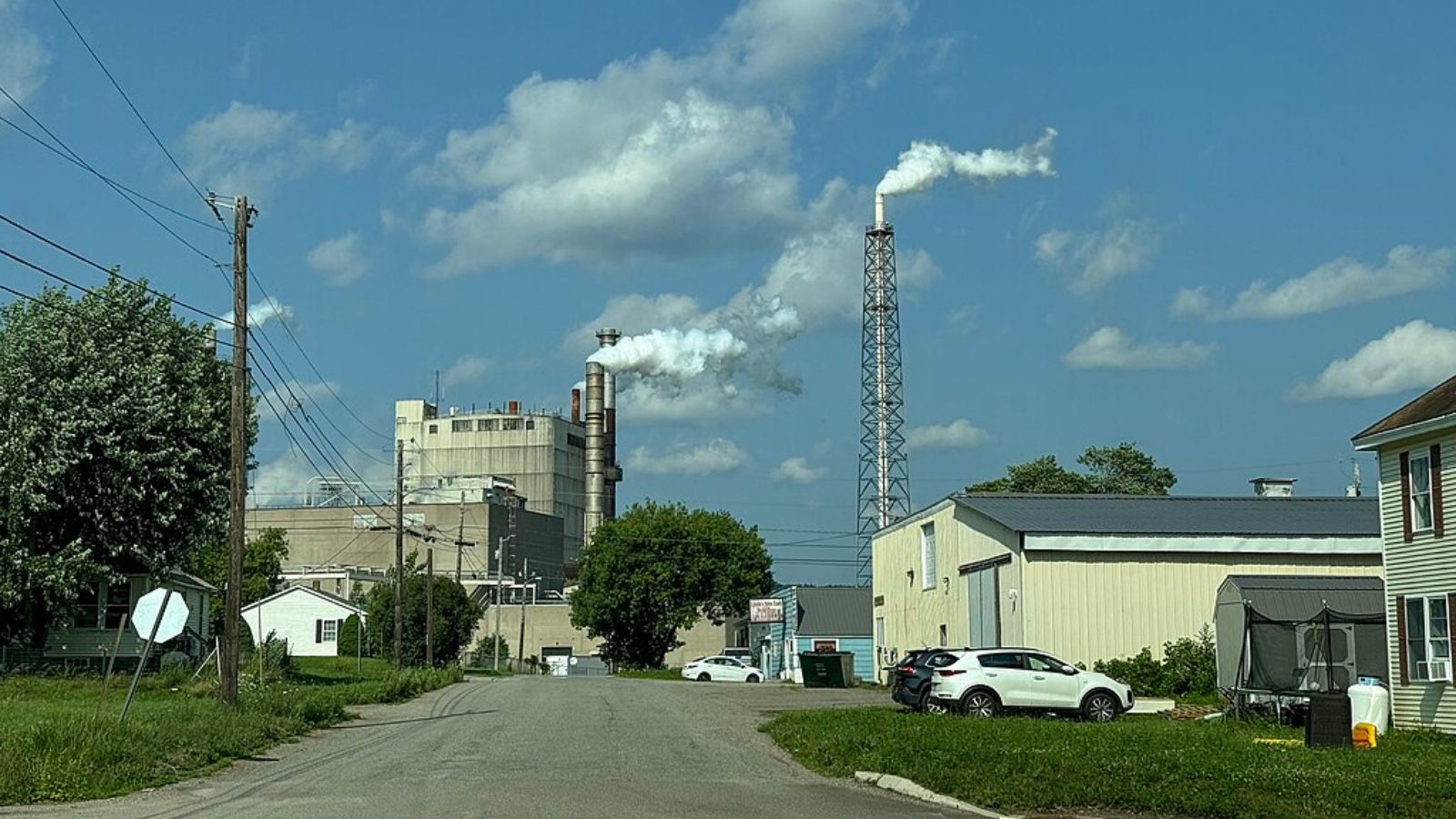
Situated in Aroostook County, Woodland is a sparsely populated area with farmland, forests, and few commercial developments. Its housing stock is modest, and most homes are set on large lots or rural acreage. Market activity here tends to be light, which can result in more volatile year-to-year swings.
Though the recent drop is notable, it doesn’t necessarily signal long-term decline. Woodland remains one of the least expensive towns in the state and may see renewed interest from buyers as affordability pressures rise elsewhere.
2. Limestone – 134.7% Home Price Increase Since 2016
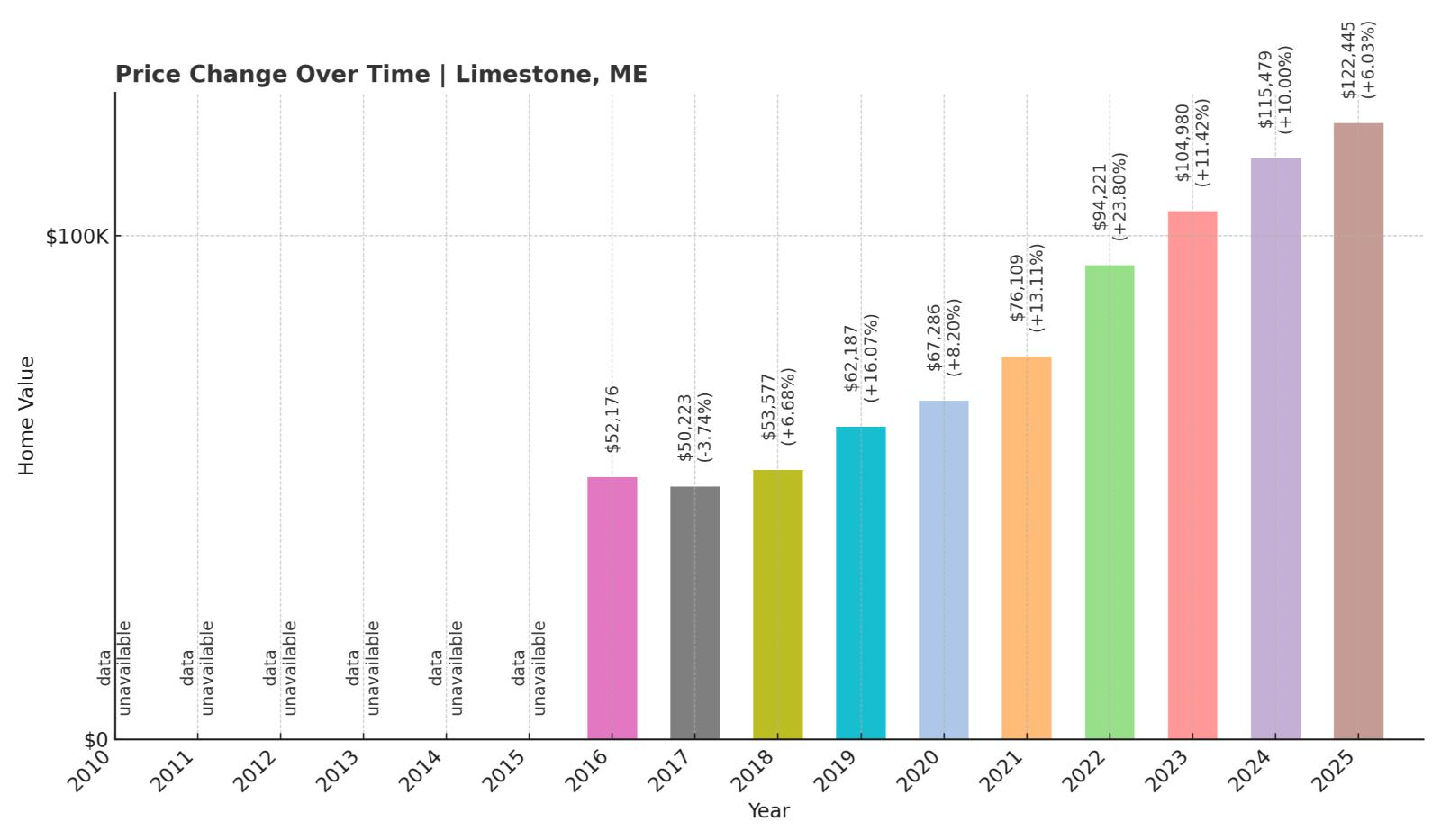
- 2010: N/A
- 2011: N/A
- 2012: N/A
- 2013: N/A
- 2014: N/A
- 2015: N/A
- 2016: $52,176
- 2017: $50,223 (-$1,952, -3.74% from previous year)
- 2018: $53,577 (+$3,353, +6.68% from previous year)
- 2019: $62,187 (+$8,610, +16.07% from previous year)
- 2020: $67,286 (+$5,100, +8.20% from previous year)
- 2021: $76,109 (+$8,823, +13.11% from previous year)
- 2022: $94,221 (+$18,111, +23.80% from previous year)
- 2023: $104,980 (+$10,760, +11.42% from previous year)
- 2024: $115,479 (+$10,499, +10.00% from previous year)
- 2025: $122,445 (+$6,966, +6.03% from previous year)
Limestone has seen more than a 134% increase in home values since 2016. After a few small fluctuations early on, prices began rising sharply in 2019 and continued to gain momentum through 2025. The consistent double-digit growth over several years has transformed the local market, although prices remain low by statewide standards.
Limestone – Rebounding From a Base of Affordability
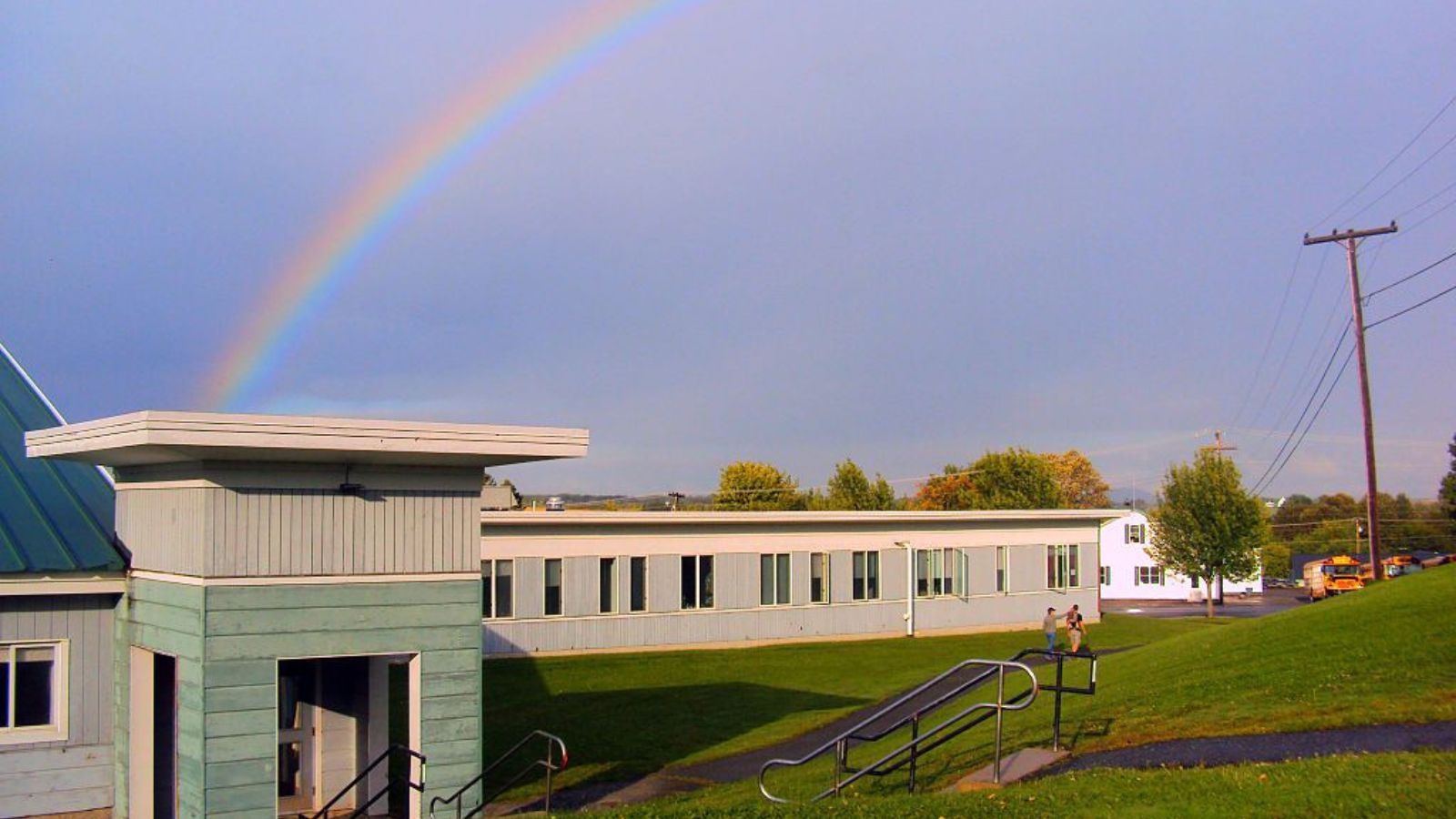
Once home to Loring Air Force Base, Limestone experienced an economic slump after the base closure in the 1990s. In recent years, however, the town has started to rebuild, supported in part by the presence of the Maine School of Science and Mathematics and new commercial tenants at the Loring Commerce Centre.
Though still very affordable, Limestone’s housing market appears to be catching up after years of stagnation. Its proximity to Caribou and Presque Isle also makes it a practical choice for buyers seeking value while staying within commuting distance of larger towns.
1. Van Buren – 55.3% Home Price Increase Since 2016
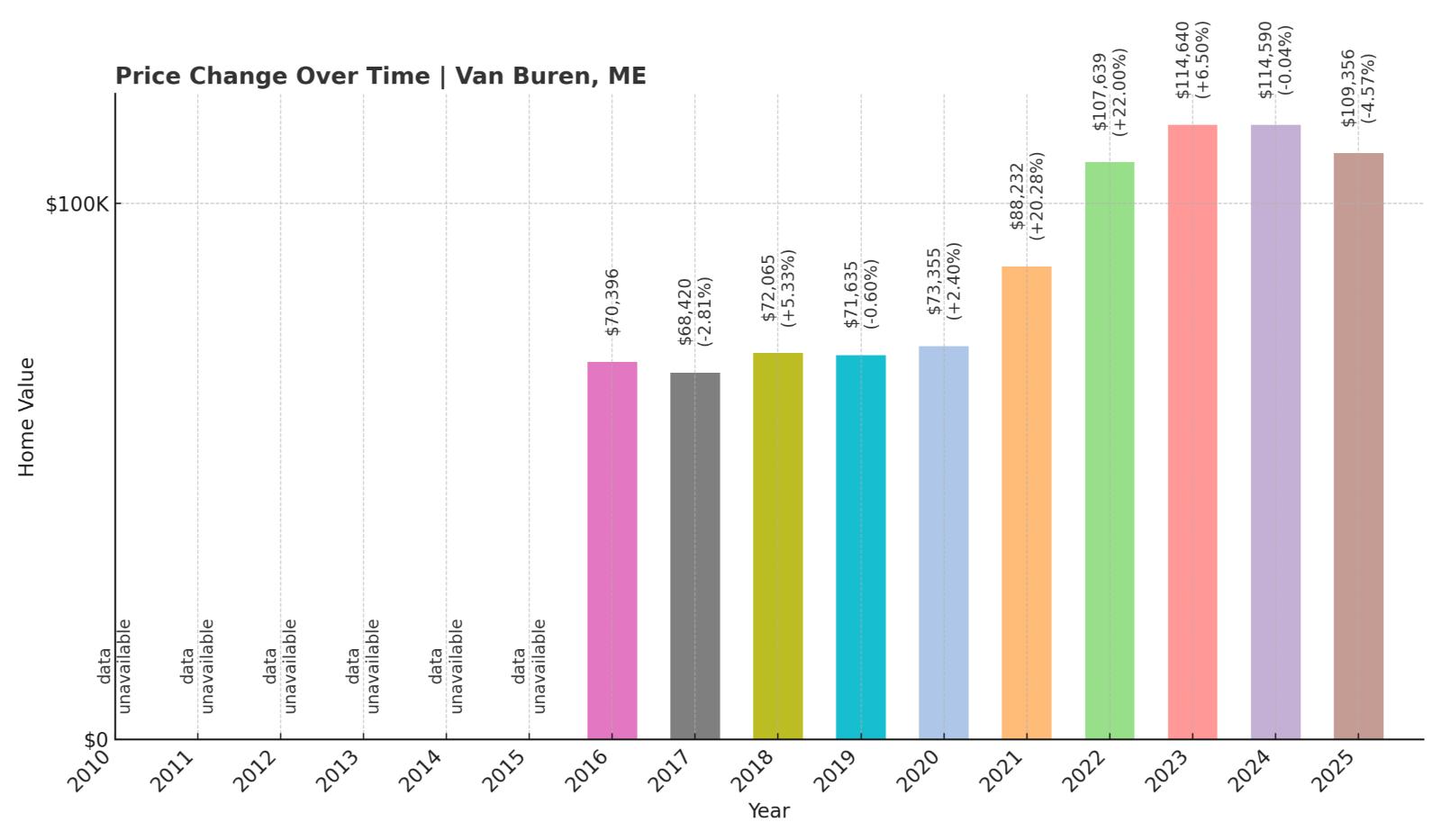
- 2010: N/A
- 2011: N/A
- 2012: N/A
- 2013: N/A
- 2014: N/A
- 2015: N/A
- 2016: $70,396
- 2017: $68,420 (-$1,976, -2.81% from previous year)
- 2018: $72,065 (+$3,644, +5.33% from previous year)
- 2019: $71,635 (-$430, -0.60% from previous year)
- 2020: $73,355 (+$1,720, +2.40% from previous year)
- 2021: $88,232 (+$14,877, +20.28% from previous year)
- 2022: $107,639 (+$19,408, +22.00% from previous year)
- 2023: $114,640 (+$7,001, +6.50% from previous year)
- 2024: $114,590 (-$50, -0.04% from previous year)
- 2025: $109,356 (-$5,234, -4.57% from previous year)
Van Buren’s home prices have increased by 55% since 2016, with the biggest jumps occurring between 2020 and 2022. However, the last two years have seen back-to-back declines, bringing the 2025 value below its 2023 peak. Despite this, the town remains the most affordable in the state based on Zillow’s June 2025 figures.
Van Buren – Maine’s Most Affordable Town in 2025
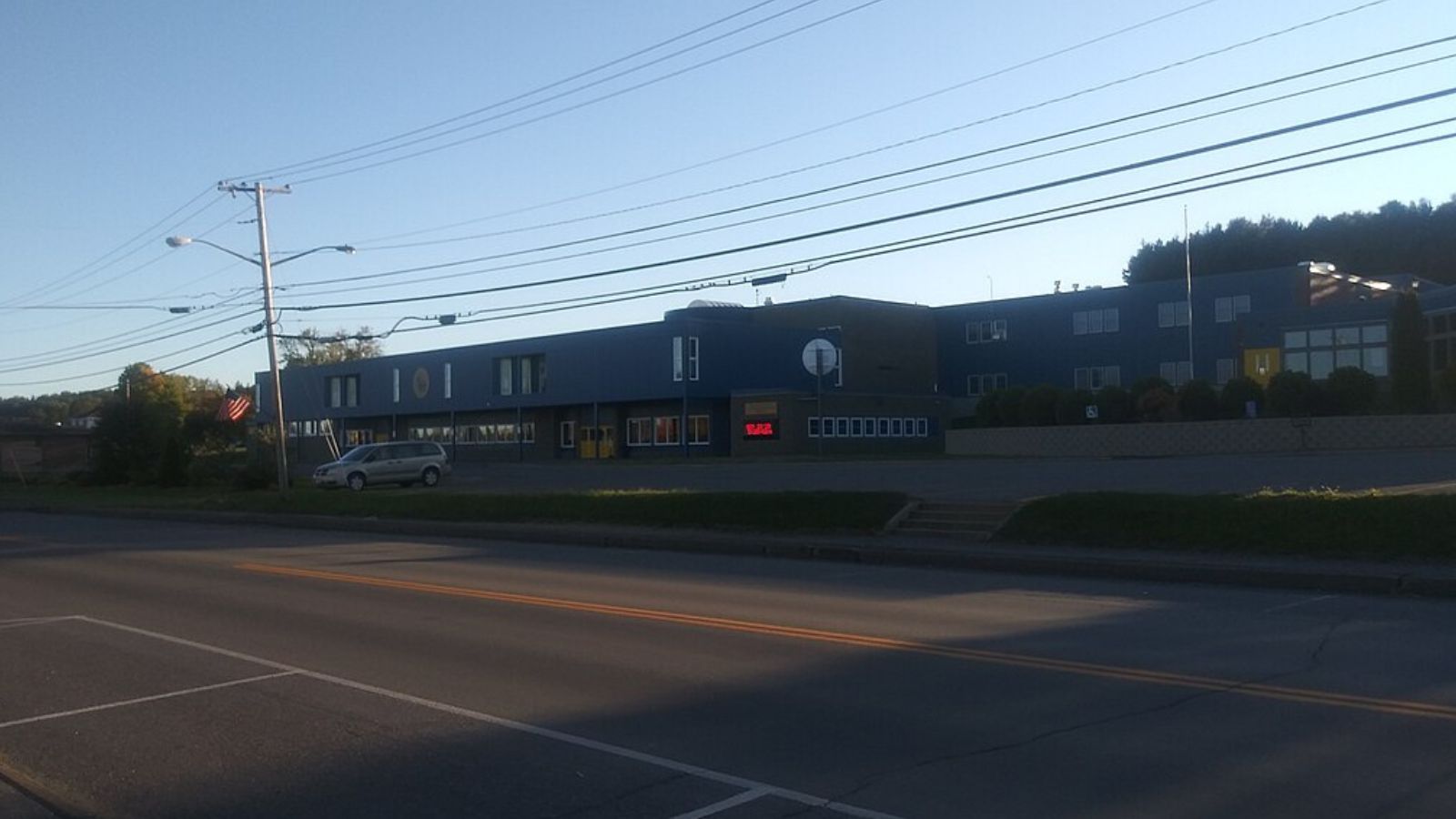
Van Buren lies along the St. John River in northern Aroostook County, directly across from Saint-Leonard, New Brunswick. It’s a bilingual community with deep Acadian roots, offering a quiet lifestyle and close-knit population. The town’s location at the edge of the state—and country—helps keep prices low.
The recent dip in values follows a dramatic run-up during the pandemic years, when remote workers and out-of-state buyers entered even the most distant markets. As that demand cooled, prices adjusted. Still, Van Buren’s extremely low cost of entry makes it a standout for affordability in all of Maine.






